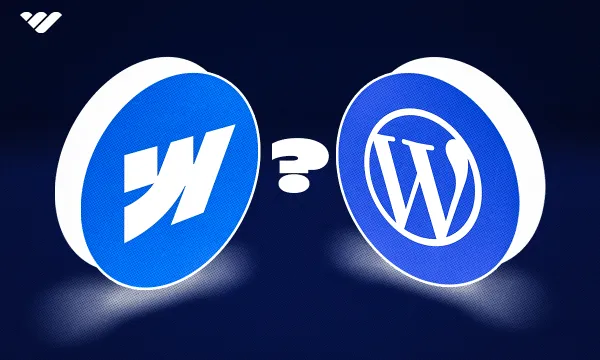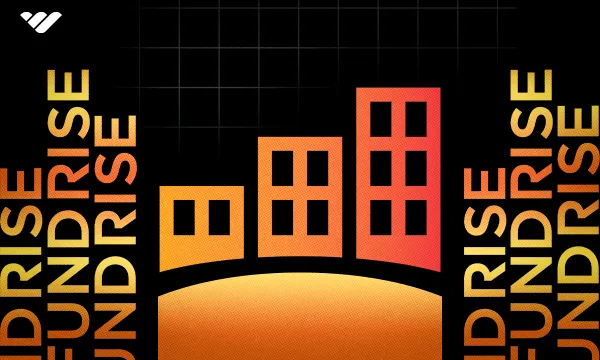If you're about to build a website and need help deciding which content management system (CMS) platform to use, WordPress and Webflow come with pretty much everything you need. While both are excellent for creating websites, they are designed for different types of users (and they're not the only option).
Webflow is all about making design simple and compact, while WordPress is super flexible and includes tons of plugins to customize your site however you want. Either allows you to use drag-and-drop to create your site the way you like without getting too technical.
In this article, we'll walk you through the main features and some upsides and downsides of using WordPress and Webflow, so you can figure out which CMS fits the bill for your next website.
What Is Webflow?
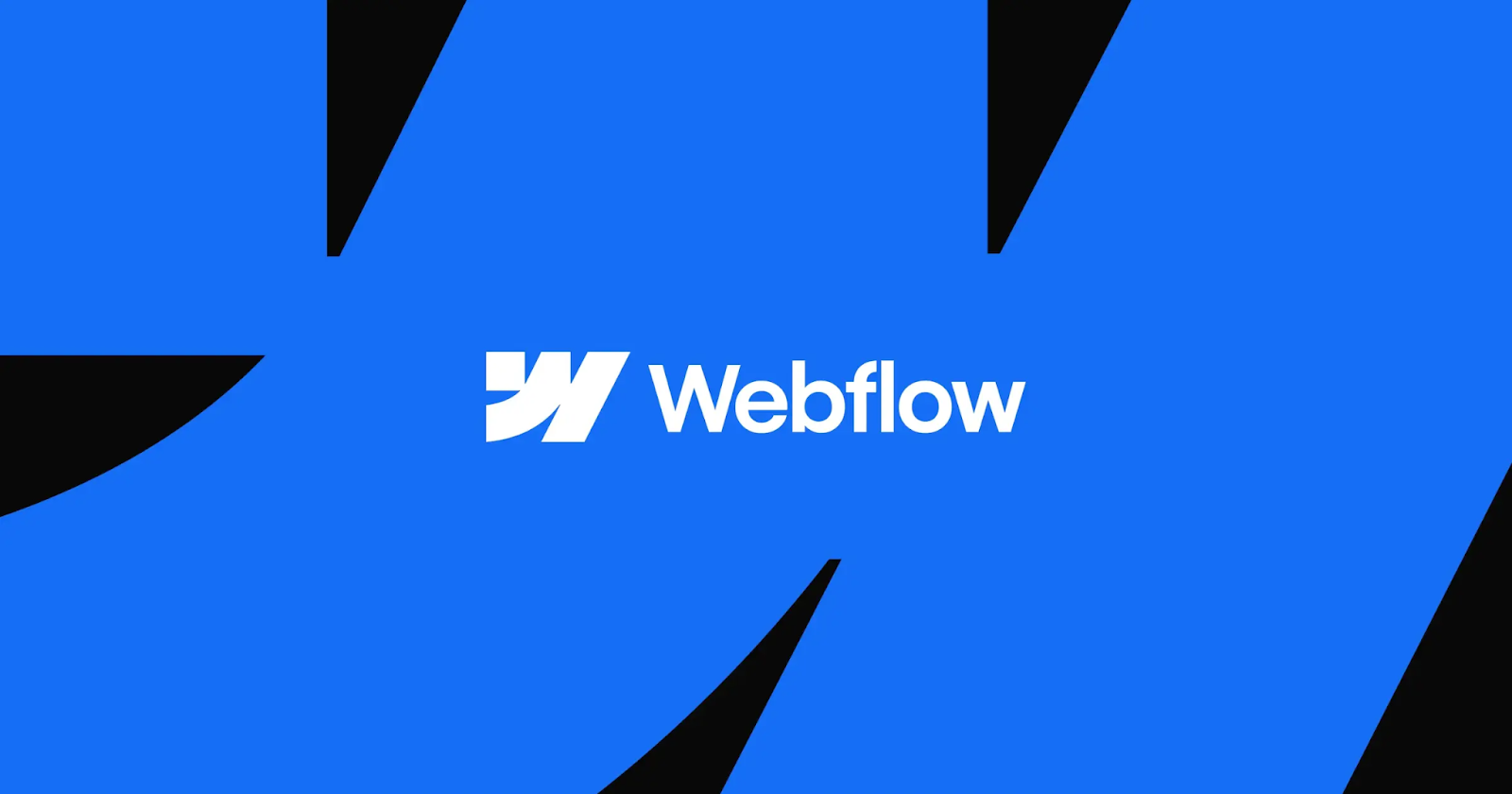
Webflow is a website development platform that helps you build websites without any coding. It gives you the freedom to design your site exactly how you want using a simple visual interface. You can create custom layouts, add animations, and build all kinds of pages using its pre-built templates. It's great if you want full control over appearance and functionality.
One of the best things about Webflow is how well it grows with your needs. You can easily update your content using its built-in CMS or by connecting it to other tools using APIs. It also works with other popular software like HubSpot and Airtable to give you a smooth workflow. If you have a working team, Webflow lets everyone collaborate and properly distribute different roles.
On top of that, Webflow offers solid hosting services, robust security, and SEO tools to rank on different search engine results pages (SERPs). The platform is built to keep your site fast and secure. The Webflow enterprise version offers advanced tools and support for bigger teams. With over 300,000 organizations using it, Webflow has become a go-to choice for creating unique, high-quality websites.
Key features of Webflow
- Design your website with a drag-and-drop editor
- Built-in CMS tool to manage content easily
- Responsive designs adapt automatically to all devices
- Build your custom online store with ecommerce elements
- Add cool animations and interactions without needing to code
- Provides a swift and stable hosting service
- SEO tools to optimize each page for better search visibility
- No software updates or external plugins required
Who is Webflow for?
Webflow is great for designers, freelancers, and small businesses who want full control over their website's look without having to code. It's perfect if you love designing and want a beautiful, modern site with cool animations. However, if you're building something big or complex, Webflow might feel a bit limited. It's ideal if you care more about the site design than technical stuff, such as the features and functionalities.
Webflow pros and cons
Let's get through some of the most significant advantages and disadvantages of Webflow.
What are the advantages of Webflow?
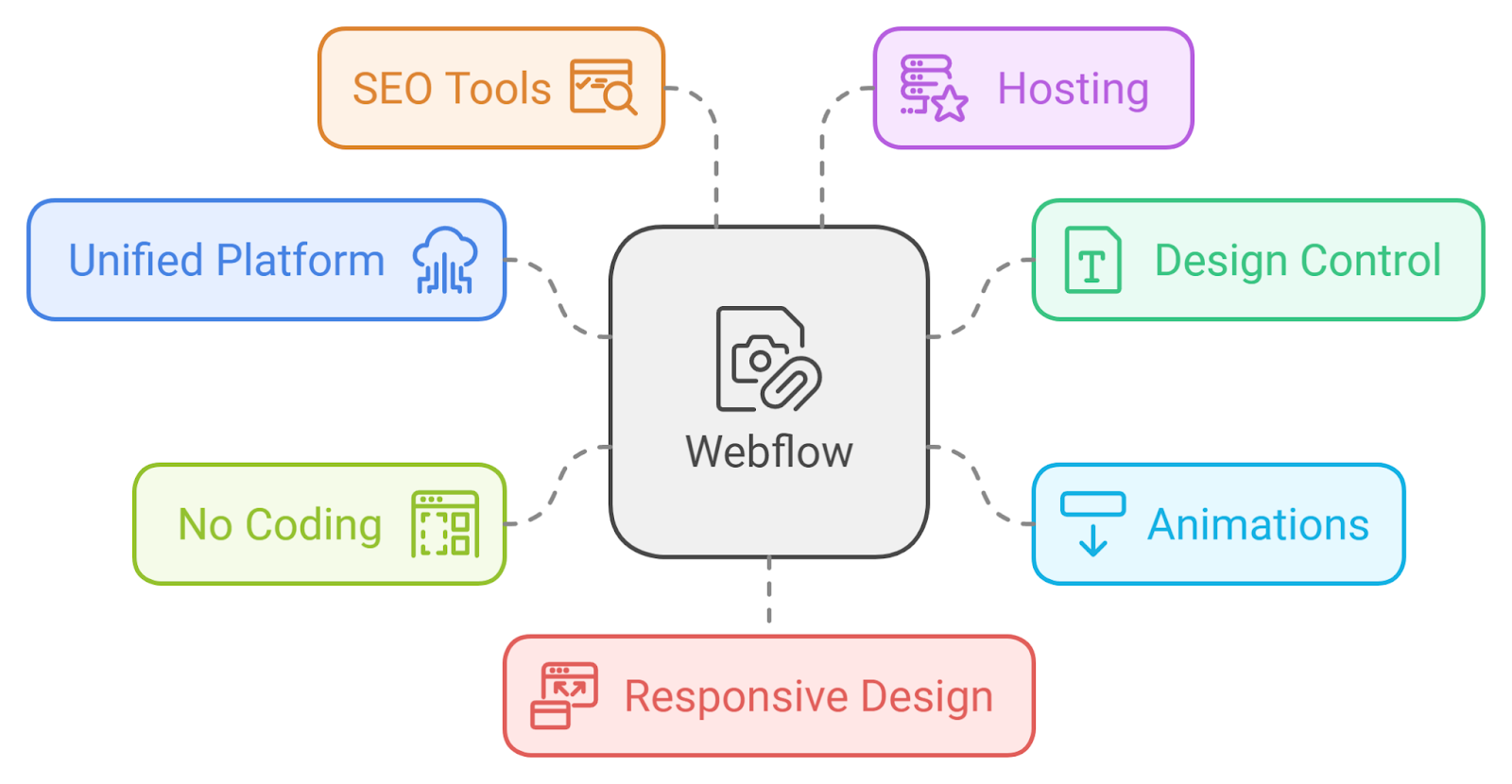
Everything in one place
Webflow simplifies the process by bringing design, hosting, and content management together on a single platform. You don't need to juggle between different services. Everything is in one place and connected to make it easier to manage your website from one spot.
Full control over your design
Webflow gives you total freedom to design your site exactly how you want. With its drag-and-drop editor, you can build a professional-looking website without having to write a single line of code. Moreover, you actually get what you see in the editor—no guessing involved.
Built-in animations and interactions
If you want to make your site more dynamic, Webflow lets you easily add smooth animations and interactions to your pages. You can create eye-catching effects and transitions without needing to be a coding or an animation expert.
No coding required
Even if you don't know any programming languages like HTML or CSS, Webflow lets you create beautiful, fully functional websites. Its user-friendly interface is designed for non-developers, so you can focus on creating your vision without worrying about the technical stuff.
SEO-friendly tools built right in
Webflow makes SEO easy. You can edit meta tags, customize URLs, and add alt text to images—all within the platform. No need for extra plugins to get your site ready for search engines.
Fast and reliable hosting
Webflow provides fast and reliable hosting with a global content delivery network (CDN). It helps your website load quickly for visitors around the world. And since Webflow handles the hosting, you don't need to worry about server or cache management work.
Responsive design
Webflow automatically ensures your site looks great on any device—whether it's a desktop, tablet, or phone. You can tweak the design for different screen sizes, but Webflow takes care of the basics, so your website is mobile-friendly right out of the box.
What are the disadvantages of Webflow?
It can get pricey
While Webflow offers a lot, the cost can add up, especially if you need advanced features or ecommerce functions. The free plan has limited functionality, so if you want more options, like CMS or custom domains, you'll need to upgrade to a paid plan.
Not ideal for large or complex sites
Webflow is great for small to medium websites. However, if you're planning to build a large site with tons of content or need something like a big online store, you might run into some limits. Webflow doesn't have the same plugin ecosystem as WordPress, which could make adding extra features tricky.
Takes time to get used to
If you're new to web design or don't know much about features like margins and padding, Webflow might feel a little overwhelming at first. It's designed for visual control, but there's still a small learning curve for beginners.
Limited third-party integrations
Unlike WordPress, which has tons of plugins for just about anything, Webflow has fewer built-in integrations. If there's a feature Webflow doesn't offer, you may need to find a workaround or custom-build the solution, which can be more time-consuming and somewhat costly.
How does Webflow work?
Now, we'll look at how to set up your website with Webflow.
Sign up for Webflow
First, go to Webflow's site and sign up for an account. Once you log in, you'll land on your dashboard. Click New Site to start creating your website.
You can pick Blank Site if you want to design everything from scratch or a Template (both free and premium) that you can customize, or you can complete some tutorials beforehand.
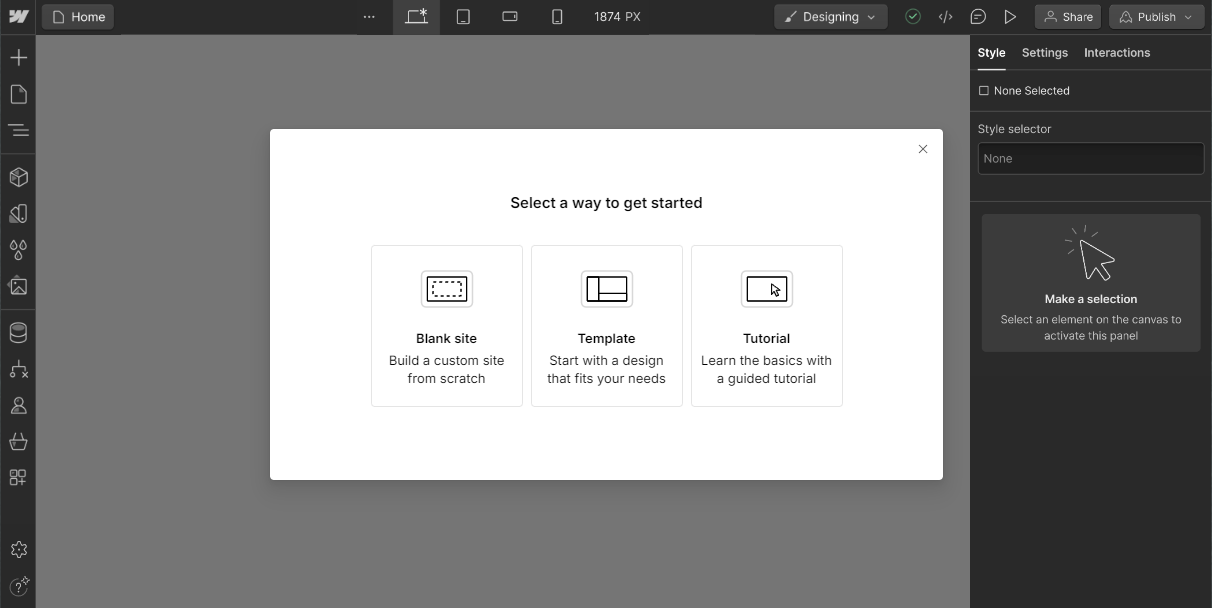
Using templates and customization
Once you pick your template or start from scratch, it's time to play around with the design. Webflow makes this easy with its drag-and-drop interface.
You can change up the fonts, add images, or create different sections for text, buttons, and menus. It's kind of like building a digital scrapbook—drag the stuff you want onto the page and drop it in place.
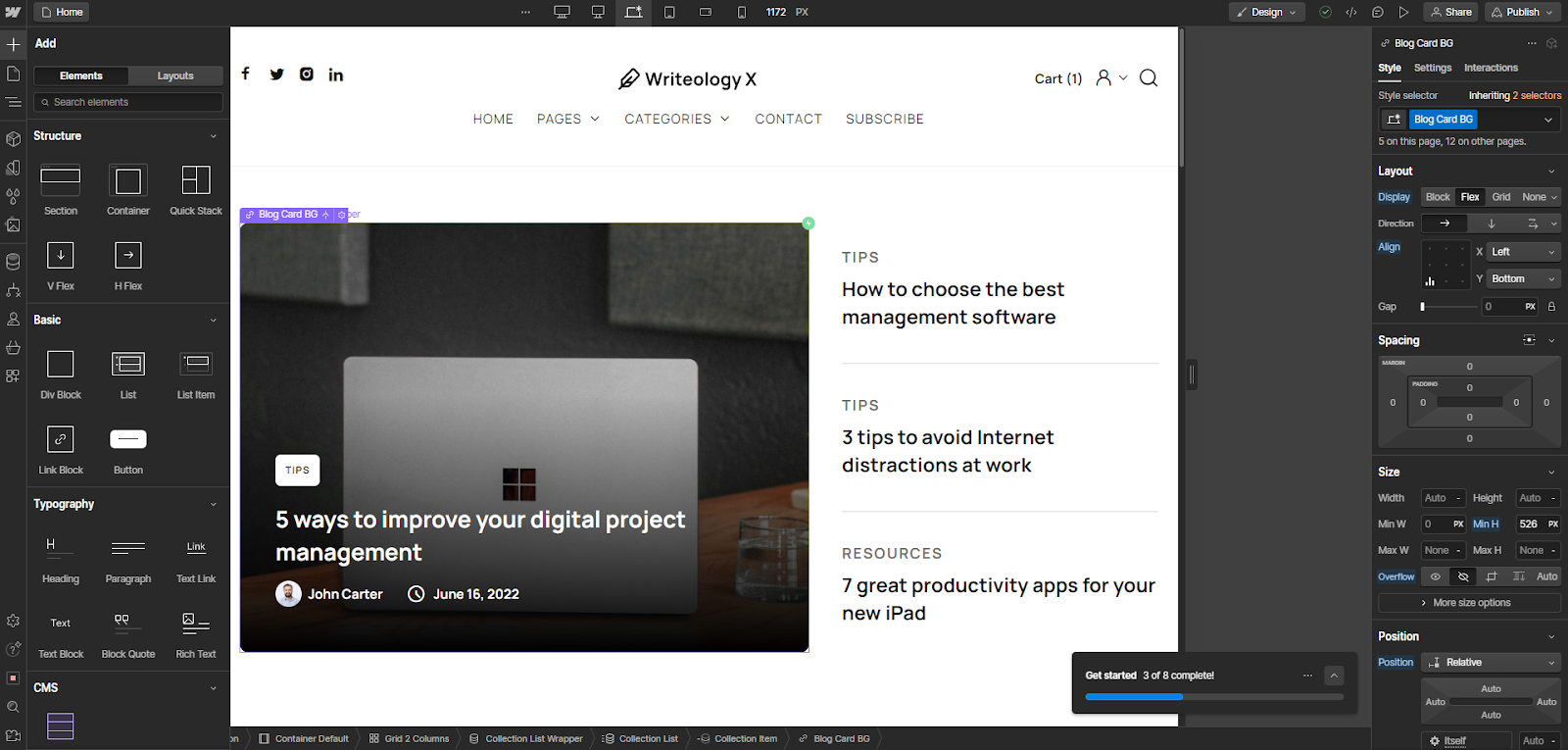
Content and dynamic elements
Webflow lets you manage content like blog posts, portfolio items, or even products if you're building a blog site. If you want some movement on your site, like sliders or cool animations, Webflow can do that, too.
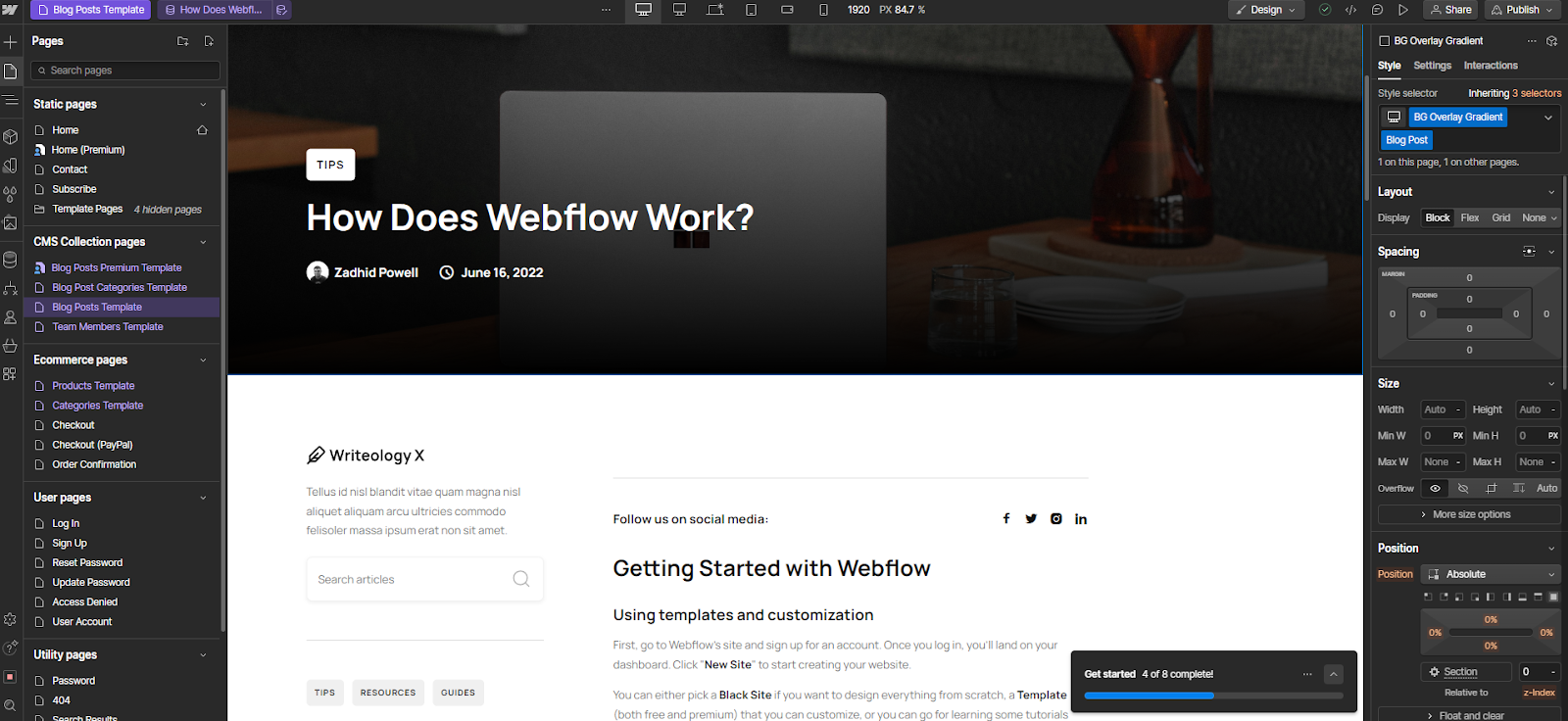
Publishing your site
When everything looks perfect, hit the publish button. If you're using the free plan, your site will have a webflow.io domain (like zadhid-powell.webflow.io).
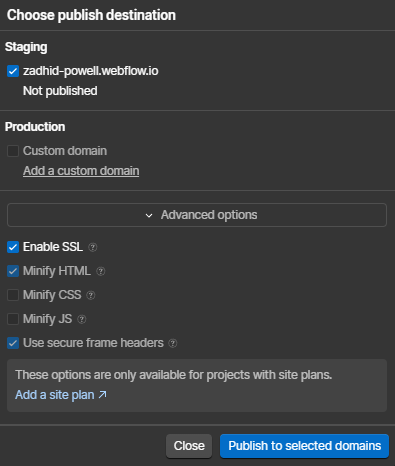
But if you upgrade to a paid plan, you can connect your custom domain (like zadhidpowell.com). Webflow takes care of the hosting, so you don't need to worry about finding a separate hosting service.
What Is WordPress?

WordPress is a free and simple tool that lets you create websites or blogs, even if you don't know how to code. It's been around since 2003 and is now the most popular website builder on the internet. Over 43% of all websites use WordPress. Whether you want to start a blog, build a business website, or set up an online store, WordPress makes it easy to manage everything from one place.
WordPress is super flexible, and you can customize it however you want. You can choose from tons of different themes to make your site look exactly how you want, and you can add plugins to give it extra features, like adding an online shop or contact forms. Big names like Microsoft and even The Rolling Stones use WordPress for their sites. It's also perfect for anyone who wants to create a personal website or share their passion with the world.
The best part? WordPress is free to use. You just need to pay for a domain and hosting, and the system comes totally free of cost. And don't worry if you're not a tech pro—WordPress is designed to be user-friendly, so you can start building your site quickly.
Key features of WordPress
- Simple and quick website setup to publish content
- Flexible in building any website, from blogs to ecommerce
- Simple tools to create, schedule, and organize your content
- Supports multiple management roles like administrators, editors, and authors
- Drag-and-drop features for site and media management
- SEO-optimized design to perform in SERPs
- Thousands of plugins to add cool features, from social media to spam protection
- Massive and active community support to get help and advice
Who is WordPress for?
WordPress is great for anyone who wants flexibility—whether you’re starting a personal blog or running a big business. It’s perfect if you like having lots of control over your website. Developers usually love it, but even if you’re not a tech expert, you can still do a lot with plugins. While it takes some time to learn, it’s good if you want to grow your site and add more features as you go.
WordPress pros and cons
Let's look at some of WordPress's most significant advantages and disadvantages.
What are the advantages of WordPress?
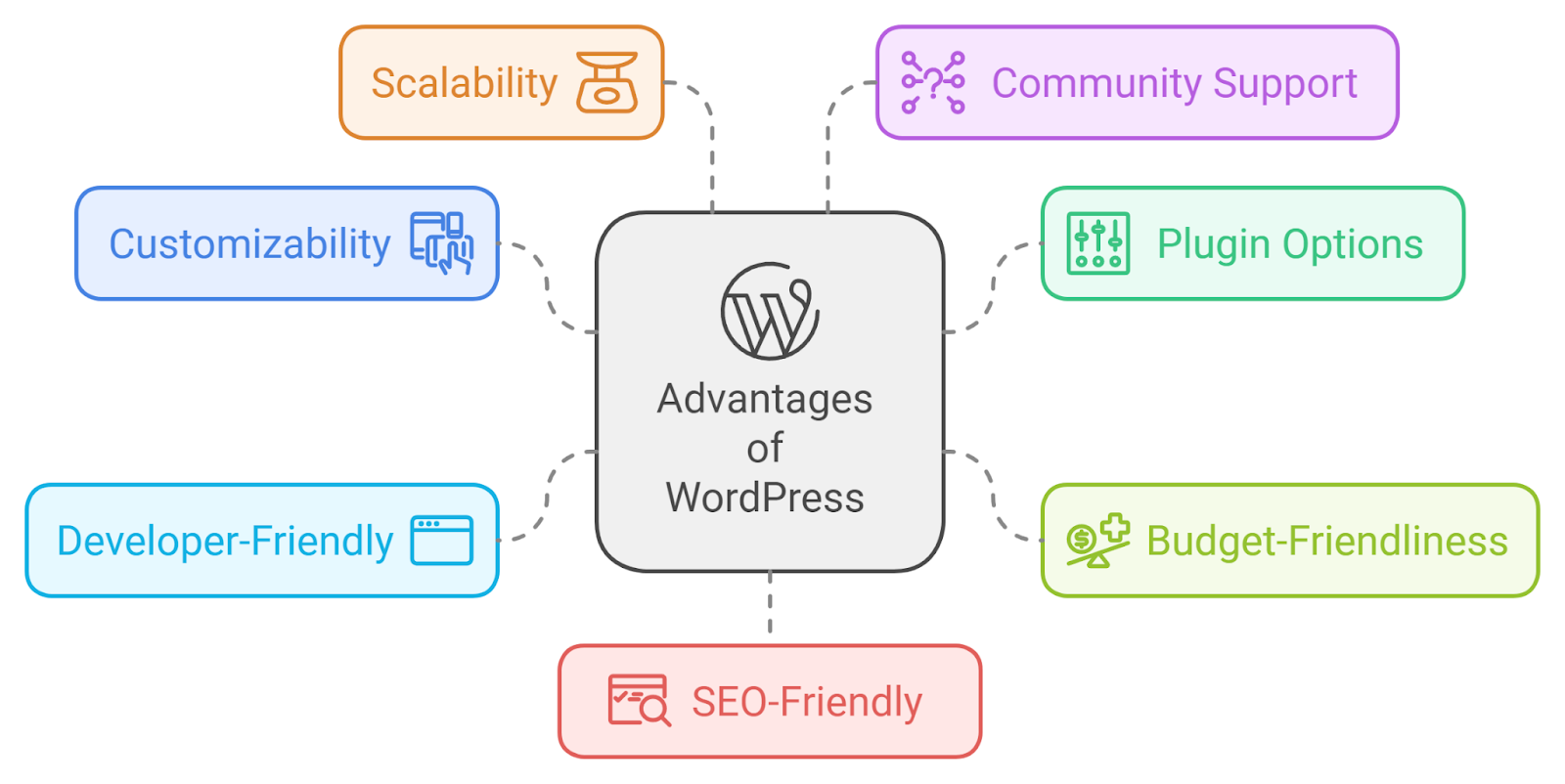
Super customizable
WordPress is like a blank canvas—you can build anything from a simple blog to a full-on online store or even a membership site. With a handful of plugins and themes available, you can customize your website exactly how you want it. It's completely your playground. Your imagination is the limitation.
Endless plugin options
Need to add a new feature? There's probably a plugin for it! WordPress has thousands of plugins—SEO, ecommerce, forms, you name it. This means you can easily add diverse or new functions to your website without having to code anything.
Budget-friendly
The WordPress software itself is free, and you can find affordable hosting so that it won't break the bank. Many plugins and themes are free too, or you can grab some that offer lifetime deals, so you're not paying monthly fees forever.
Perfect for developers
If you know a bit of coding (PHP, JavaScript, or CSS) or are working with a developer, WordPress gives you a ton of control. Since it's open source, you can tweak almost anything to make it fit your exact needs. You won't hit a wall in terms of what's possible.
Scales with your growth
Whether you're just starting with a simple site or growing into a larger business, WordPress can handle scaling with you. You can easily scale up as your traffic grows and add more advanced features without worrying about limitations.
Strong and active community support
WordPress has a massive community behind it, which means there's always help available. From forums to tutorials and how-to guides, you'll never be alone if you run into an issue or need advice on improving your site.
SEO-ready
WordPress is built with SEO in mind, helping your site rank better on Google. There are also awesome plugins like Yoast SEO, Rankmath, or All in One SEO (AIOSEO) that make optimizing your content for search engines a breeze. This ensures your site is found on SERPs more easily.
What are the disadvantages of WordPress?
Takes some time to learn
WordPress is packed with features, which is great—but it also means there's a bit of a learning curve. If you're just getting started, it can feel overwhelming until you get the hang of it. Patience pays off here.
Plugin overload can slow you down
WordPress plugins are amazing, but if you go overboard and add too many, they can slow your site down. Besides, not all plugins are created equally. Some can cause issues or security risks, so you'll need to be selective. However, WordPress is cautious about these issues.
Maintenance is on you
Unlike platforms like Webflow, where everything is managed for you, you'll need to keep things updated on WordPress. It goes the same for both the core WordPress software and all your plugins. If you let this slide, you could end up with security vulnerabilities or site crashes.
Advanced designing can be tricky
Without a page builder like Elementor or Bricks, designing a WordPress site can be a bit of a challenge. WordPress is putting effort into making their default Gutenberg Editor to cover all your needs, but it's still a work in progress and doesn't give you the same easy experience as Webflow all the time.
How does WordPress work?
Now, we'll look at how to set up your website with WordPress.
Install WordPress
To start your WordPress site, first purchase a domain and a hosting package. Hosting providers like Bluehost, SiteGround, or HostGator offer WordPress-specific plans.
Don’t worry, it’s easy! Most hosting companies have a one-click installation option. Just click a button and WordPress gets installed on your site. After that, you’ll get a link to log in to your WordPress dashboard. This is where you’ll manage everything on your site, like adding content and customizing the look.
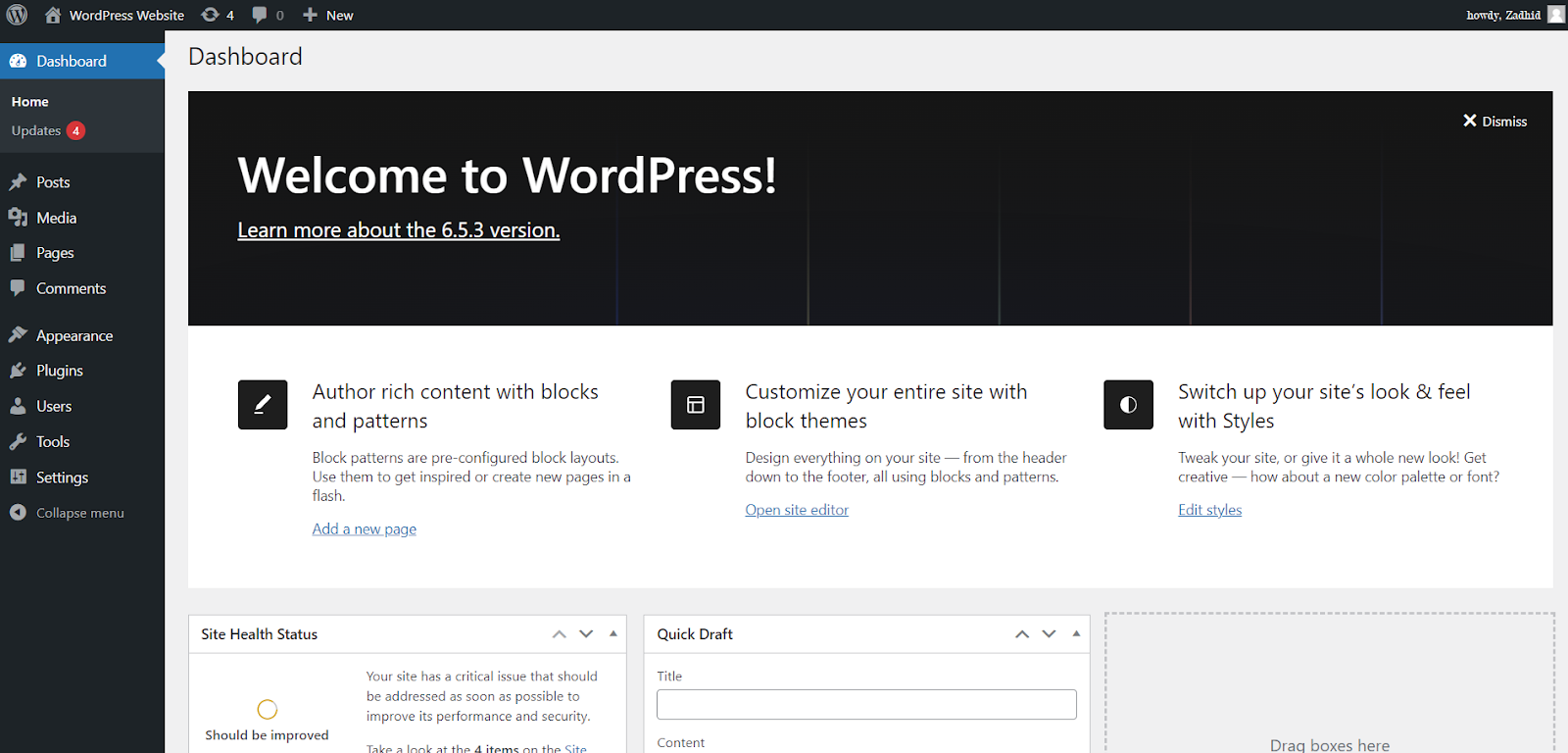
Customize your site and pick a theme
Now that you've got WordPress up and running, it's time to make your website. WordPress has themes, which are like templates that decide how your site looks.
Go to the Appearance section in your dashboard and then to Themes. There are tons of free themes to choose from, so pick one that suits your interest.
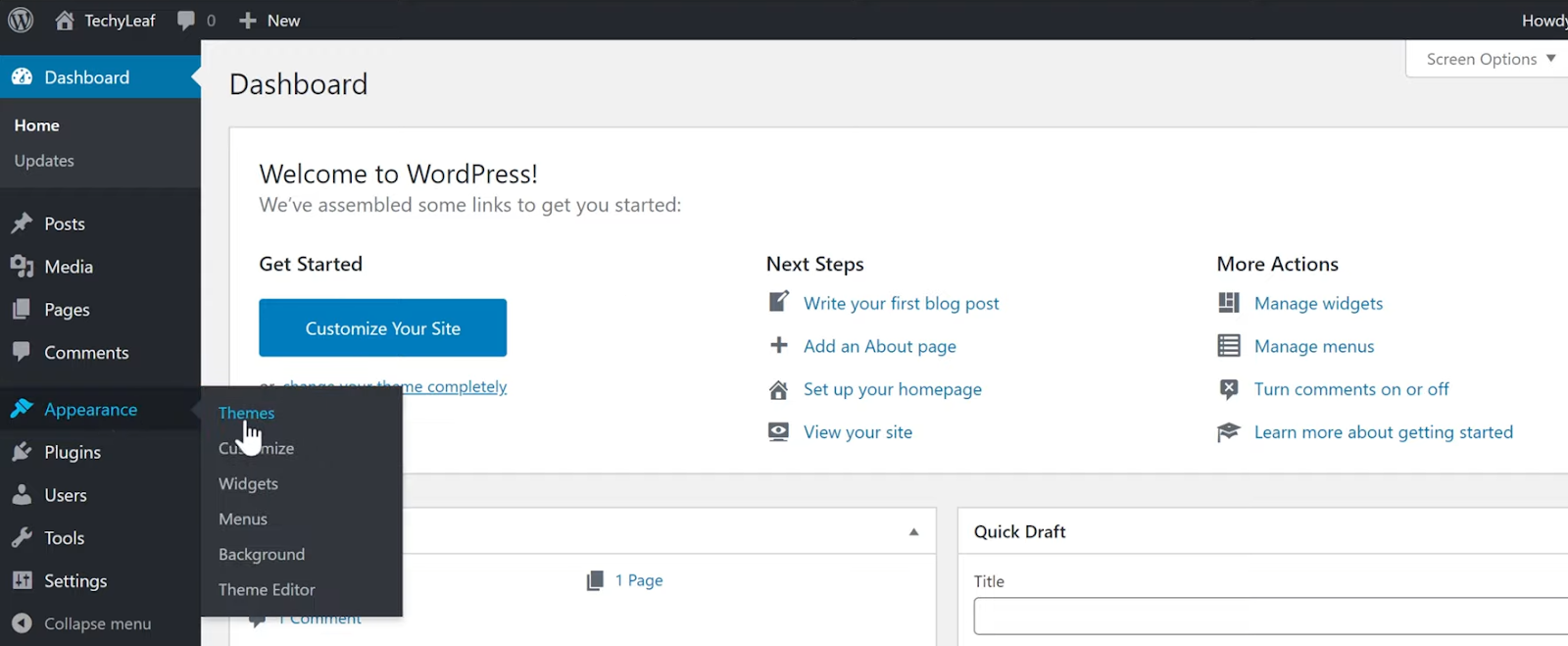
There is a default theme installed from WordPress. No worries about it. Just search or scroll for the theme you like from the collection of themes and install the one you want. You can get their premium versions from the theme developers' websites as well.
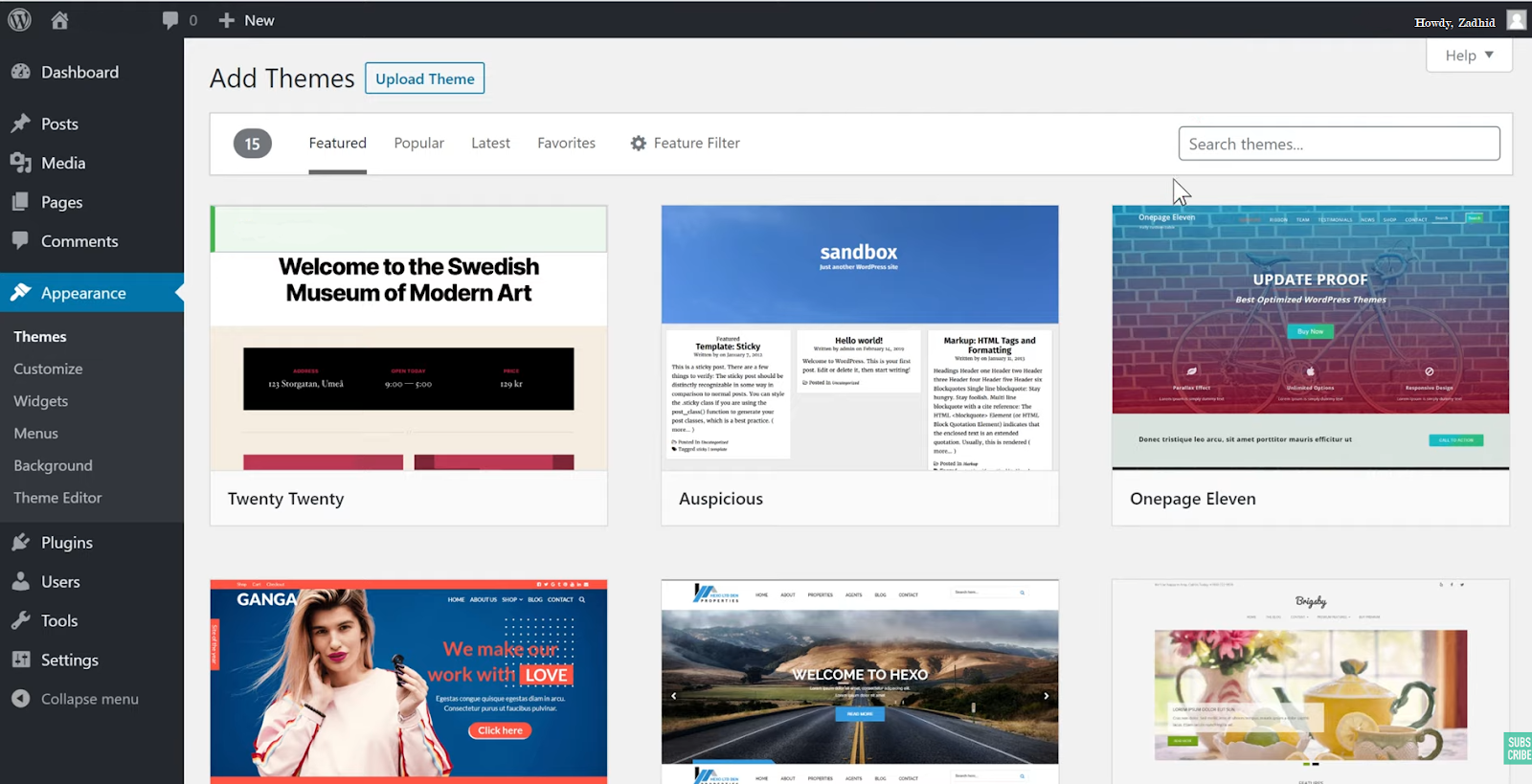
Install plugins
Plugins are like little add-ons or apps for your site. They give your website extra features without you needing to code anything. For example, if you want your site to rank better on Google, you can install an SEO plugin. They are super simple to use, and plugins boost your site visibility in SERPs.
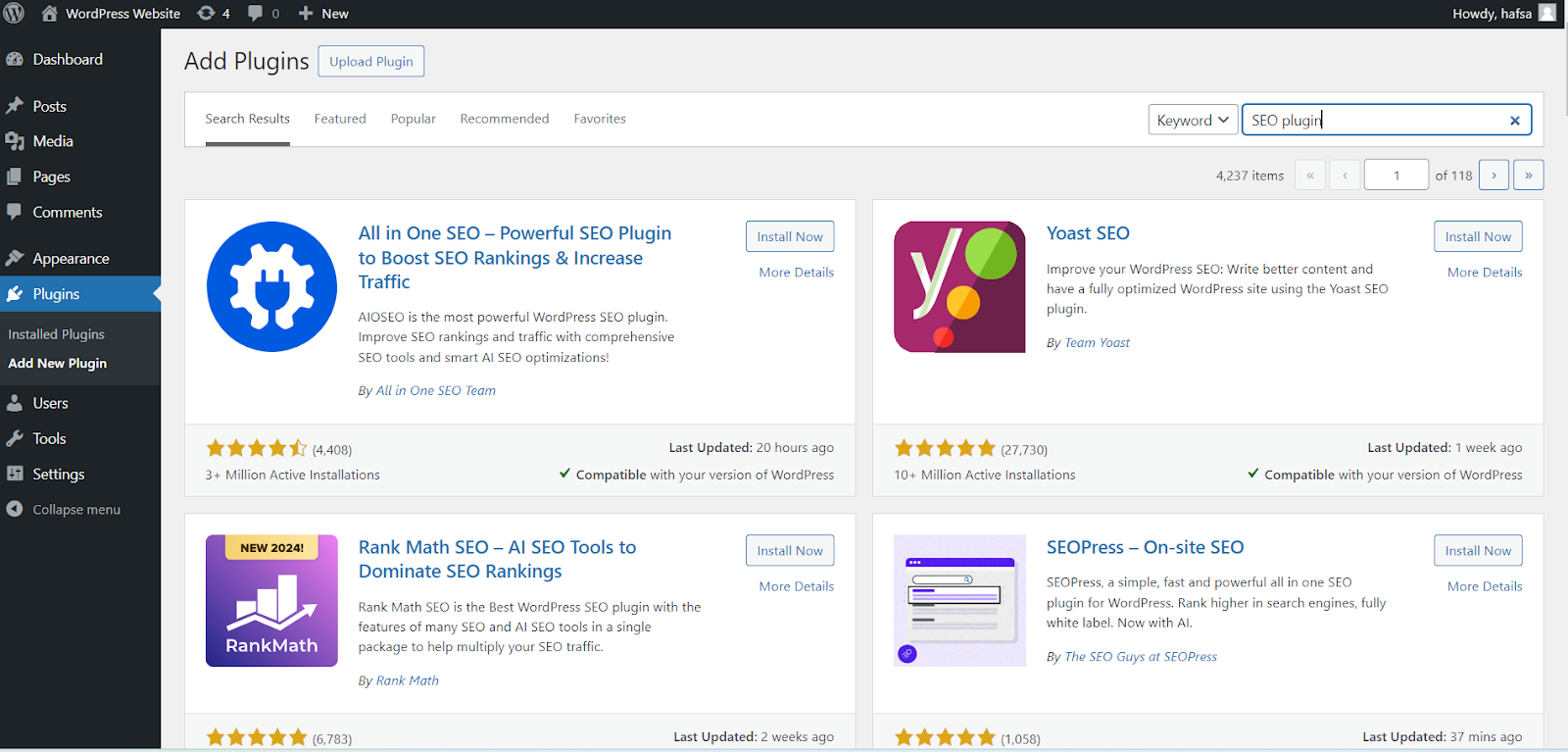
To do this, navigate to the Plugins section, click Add New, and search for whatever feature you need. We are searching for an SEO plugin in the above image. Pick any plugin you wish to use and click on the Install Now button beside it. It will be installed on your website in seconds.
Create and publish content
Now it’s time to actually put stuff on your site. WordPress makes it really easy to create content like Posts (for blog entries) or Pages (for things like your About page).
Just go to your dashboard, click Posts or Pages, and then hit Add New. You’ll use the Gutenberg editor, which is basically a drag-and-drop tool. You can add text, images, videos, and whatever else you want. When you’re happy with it, hit Publish, and your content goes live.
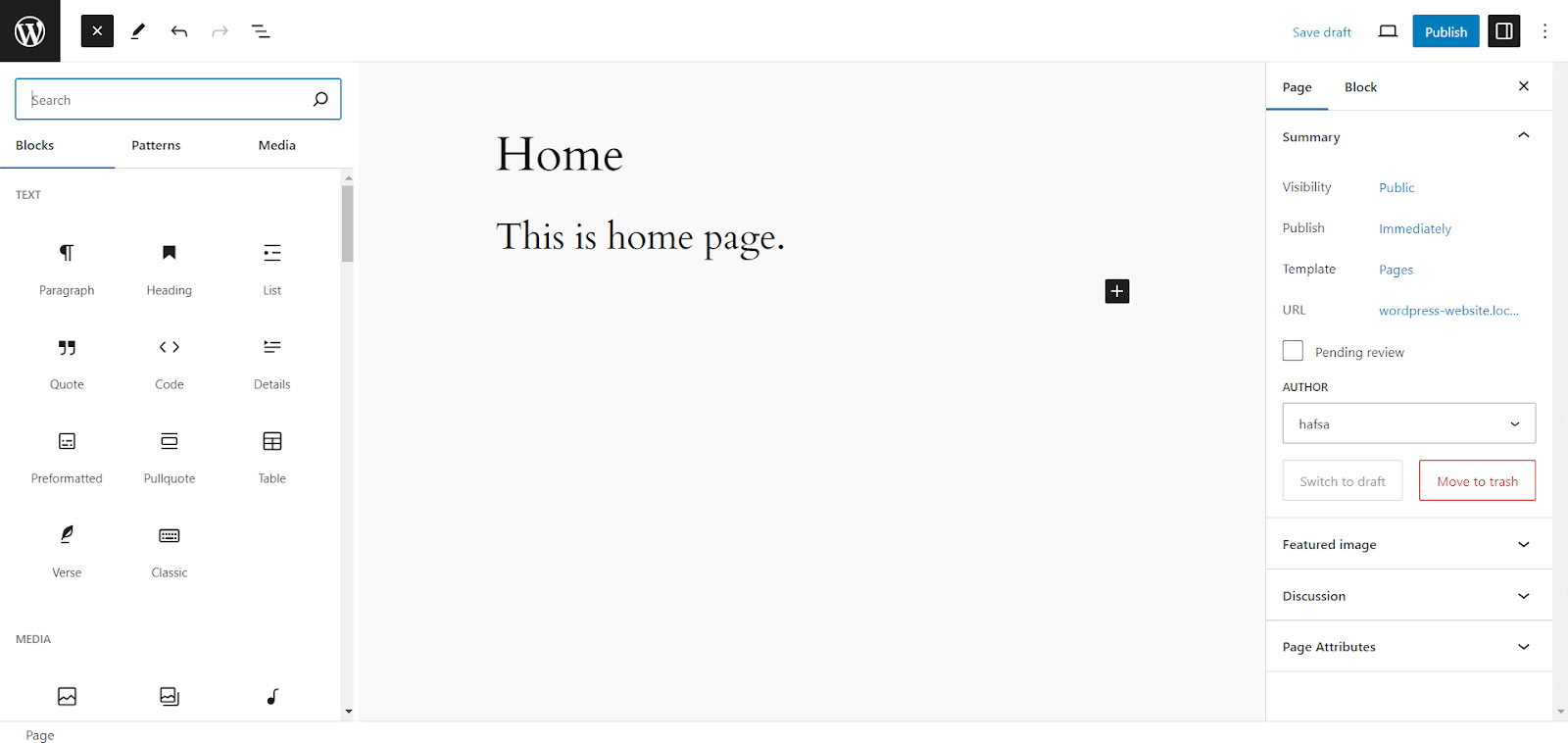
Side-By-Side Comparison of Webflow and WordPress
Let's break down how Webflow and WordPress compare so you can figure out their details.
Ease of use
Webflow is super easy to use with its drag-and-drop design. You can see everything as you build it. It's perfect for people who want to create a website quickly without much hassle.
Meanwhile, WordPress can be tricky at first. There's a learning curve, and you might need to use extra tools like page builders or block plugins to make designing easier. But once you figure it out, you can do a lot with it.
Webflow is perfect for users who want an easy-to-use visual platform. In contrast, WordPress is better if you don’t mind spending time learning the system in exchange for greater flexibility.
Design and customization
Webflow is great if you want complete control over your website's design using an editor. It has a drag-and-drop visual editor, so you can see what your site looks like as you build it. You can customize everything—from the layout to cool animations.
It's perfect for anyone who wants to create a unique and vibrant-looking website. Webflow makes it easy to design exactly how you want without being stuck with pre-made templates.
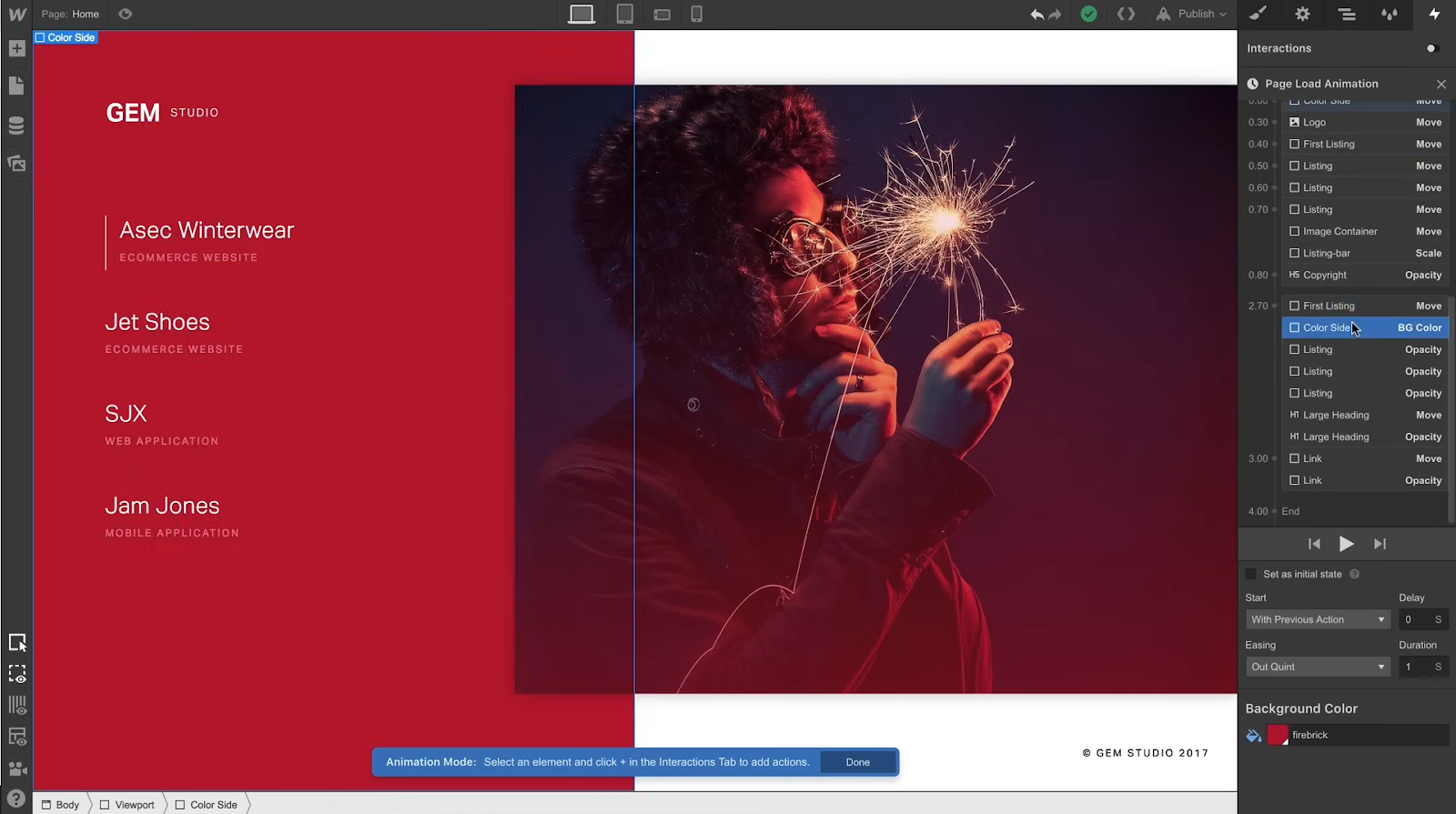
WordPress also gives you a lot of customization options. It has a built-in block editor called the Gutenberg editor. But, to fully control the design, you'll need to use themes and page builder plugins like Elementor or Bricks to get an experience similar to Webflow.
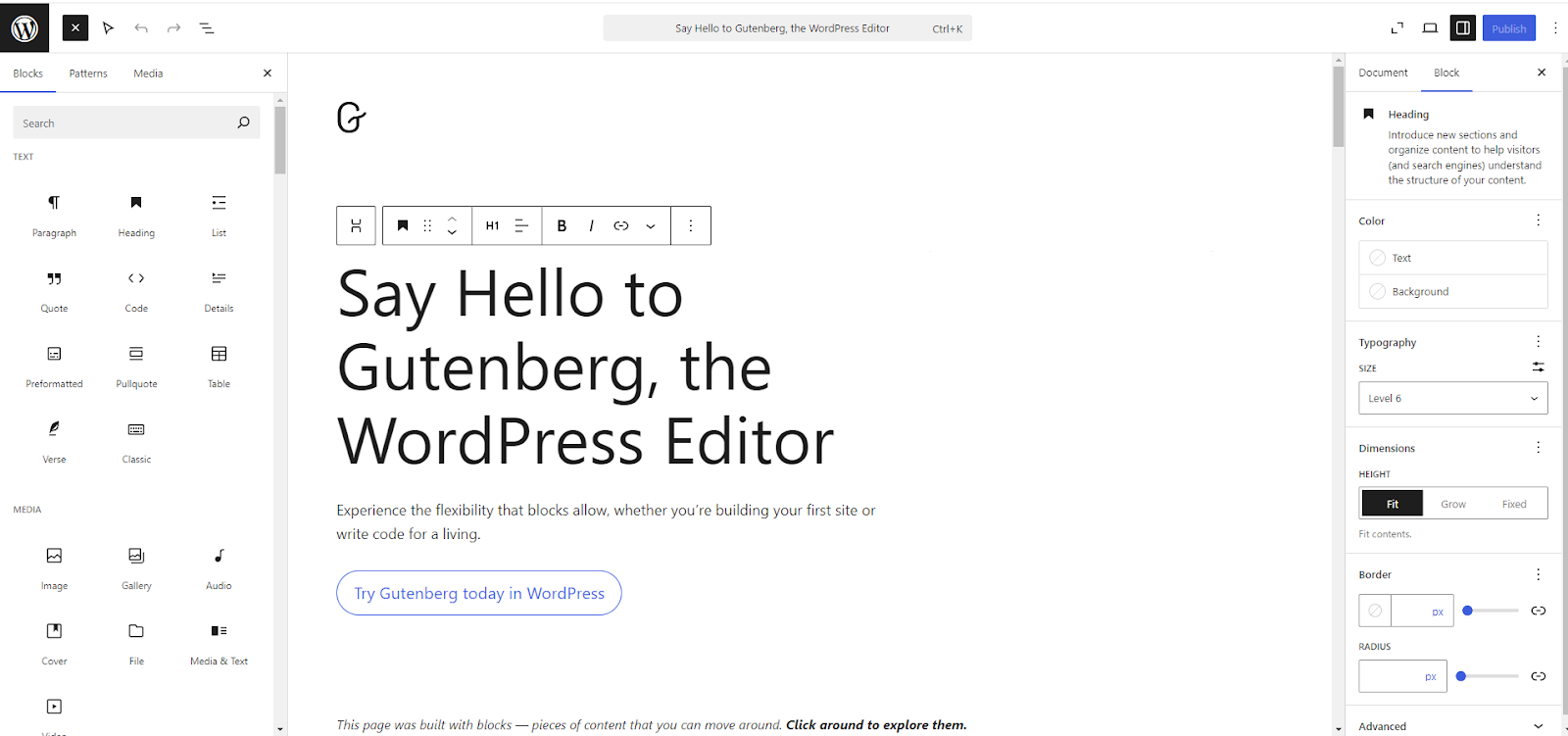
WordPress has thousands of themes you can start with and then customize further with extra tools or code. While it offers tons of flexibility, it requires more work to get your site looking exactly the way you want.
So, if you want vibrant designs with full control, go with Webflow. WordPress is great for customization but only if you are open to using extra themes, plugins, and custom codes.
Maintenance and updates
Webflow takes care of all the technical stuff, like updates and security, so you don't have to. You focus on making content and running your site—no need to worry about things breaking after an update.
Conversely, you'll have to handle your updates for plugins, themes, and the software itself with WordPress. While this gives you more control, it also means more work to ensure everything runs smoothly and stays secure.
Webflow is hands-off when it comes to maintenance, while WordPress is a solid choice if you want more control and are okay with handling updates yourself.
Security
Webflow takes care of the security, so you don't have to install or manage security plugins, worry about getting hacked, or deal with regular security updates. Webflow handles everything behind the scenes, keeping your site secure with automatic updates, SSL certificates, and protection against threats.
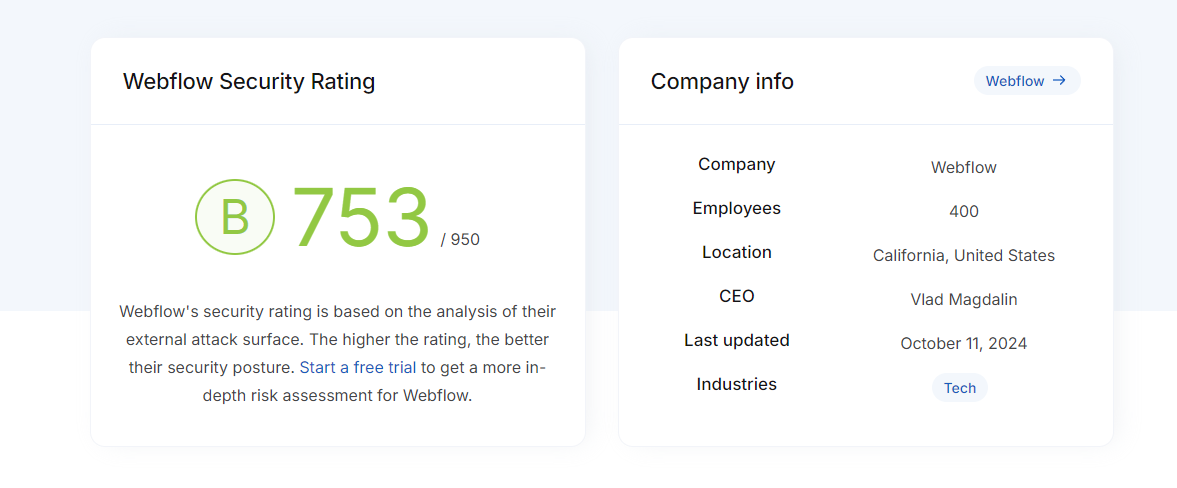
WordPress gives you more control, but that means you're also responsible for keeping it secure: "With great flexibility comes great responsibility!" So, you'll need to use some security plugins like Wordfence or Sucuri to protect your site from threats.
It's also super important to regularly update the WordPress core, themes, and plugins. If you don't, your site could be exposed to security threats. Moreover, you'll need to set up an SSL certificate to keep things extra safe, though many hosting companies include it for free.
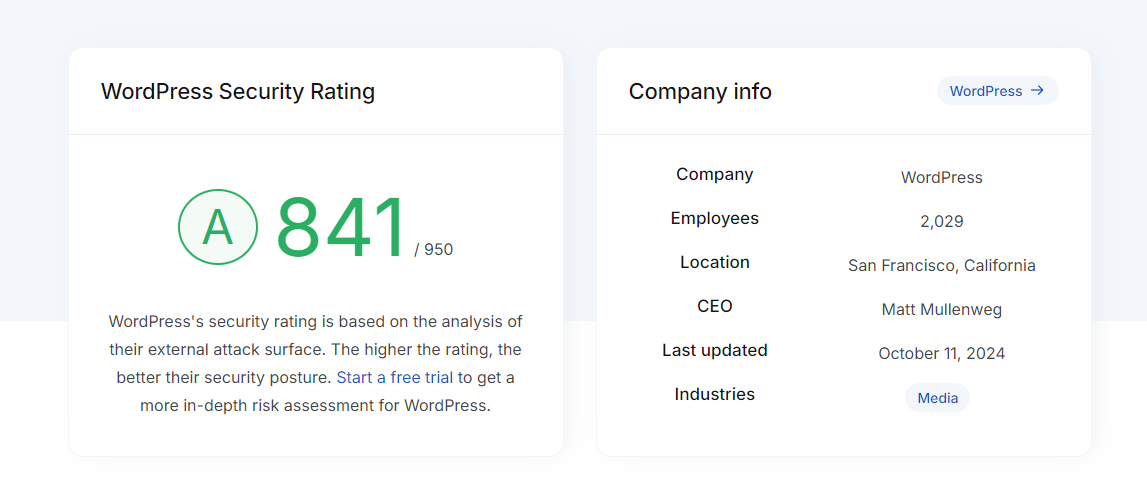
In short, if you want easy and stressless security, go with Webflow. If you like having more control and don't mind doing the extra work to keep things secure, then WordPress is a good option. The above images show how the security company Upguard rates the security of Webflow and WordPress.
Pricing
Webflow comes with all-in-one pricing plans. The plans include everything from hosting and design tools to the content manager. When you scale up, the price increases accordingly. For regular blogs or portfolio sites, it's perfectly suitable.
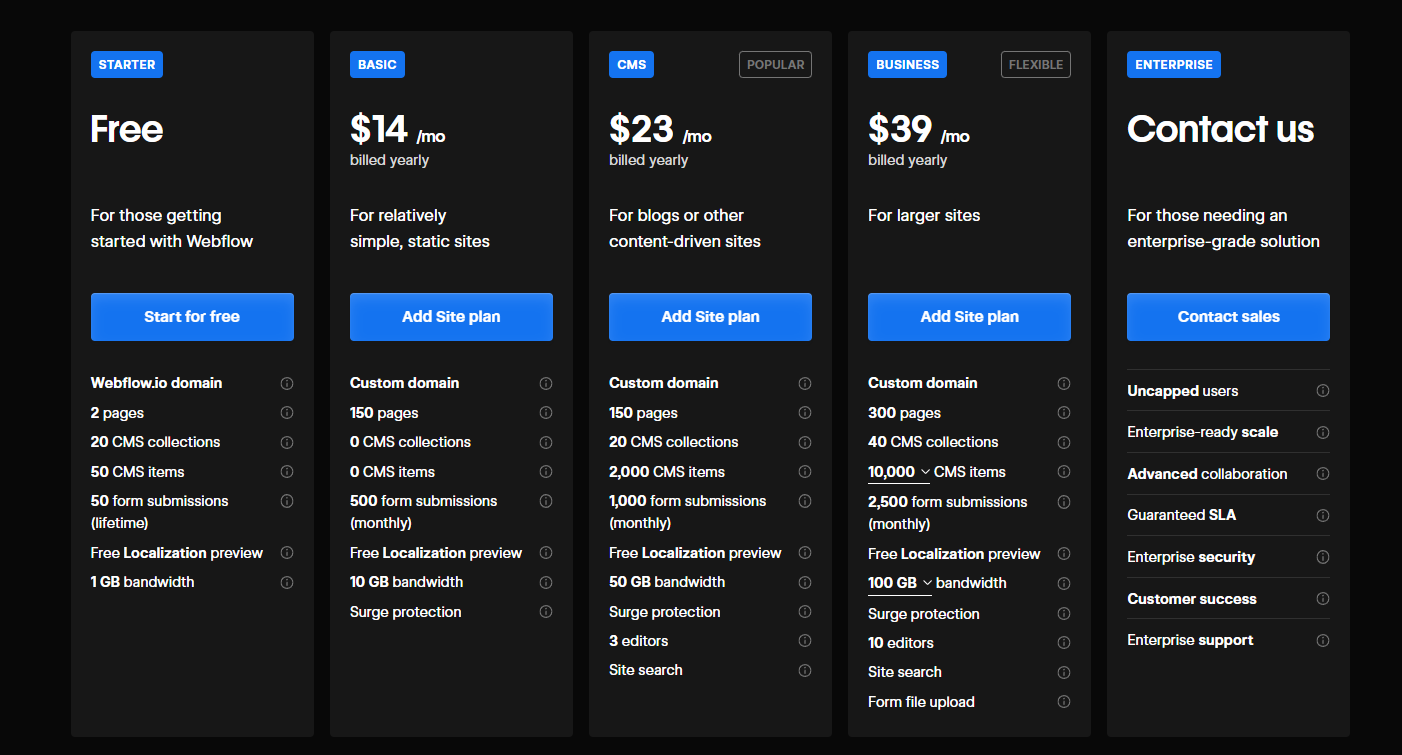
However, if you are going for an ecommerce or a larger site, the price can increase exponentially. There are dedicated ecommerce plans available for you if you are solely running an ecommerce website with Webflow. These ecommerce plans cost more than regular plans.
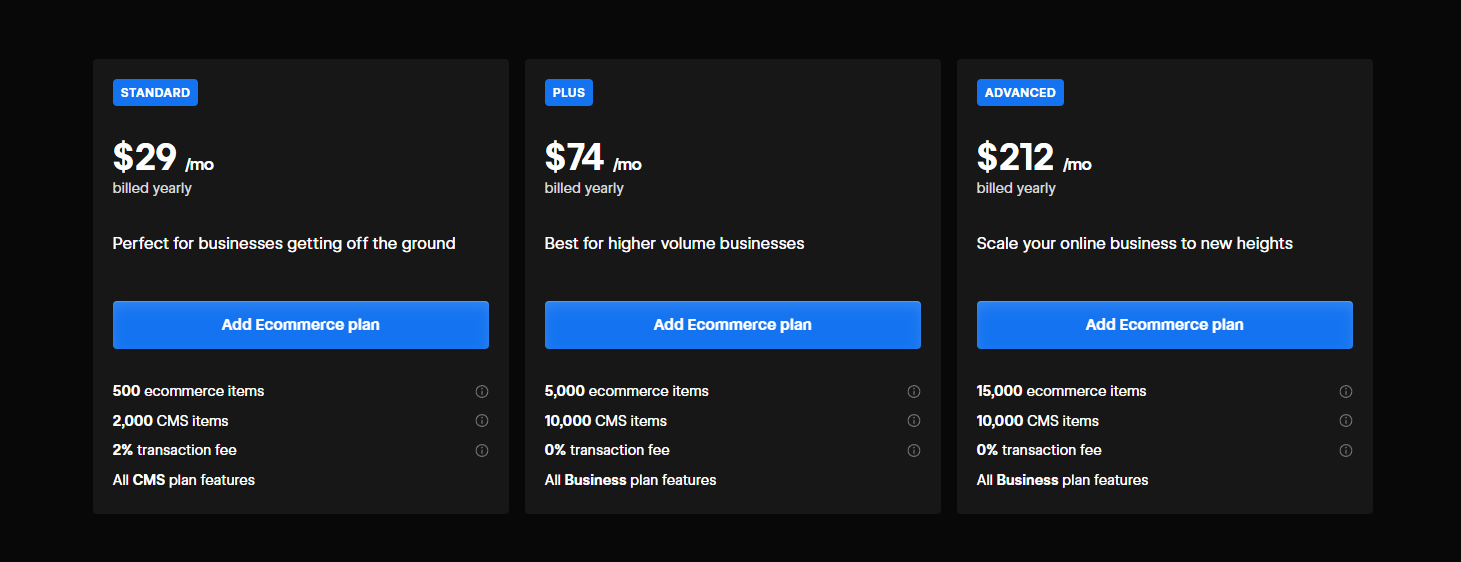
Meanwhile, the core WordPress software is free, but you'll need to pay for the hosting services. Additionally, you'll have to find premium themes or plugins to modify designs or add different features. But you can keep costs lower by choosing affordable hosting and free themes or plugins.
Using Webflow is like eating in a restaurant. The more people in your group and the more orders you place, the more the price keeps growing. In contrast, WordPress is like cooking at home; no matter how many people you cook for, the cost won't rise exponentially like in restaurants since you're shopping and cooking on your own.
Speed and performance
Webflow is built for fast performance right from the start. It has its own hosting and uses a global CDN service. It makes sure your site will load quickly. You don't have to worry about setting up anything extra like caching services because Webflow handles everything for you.
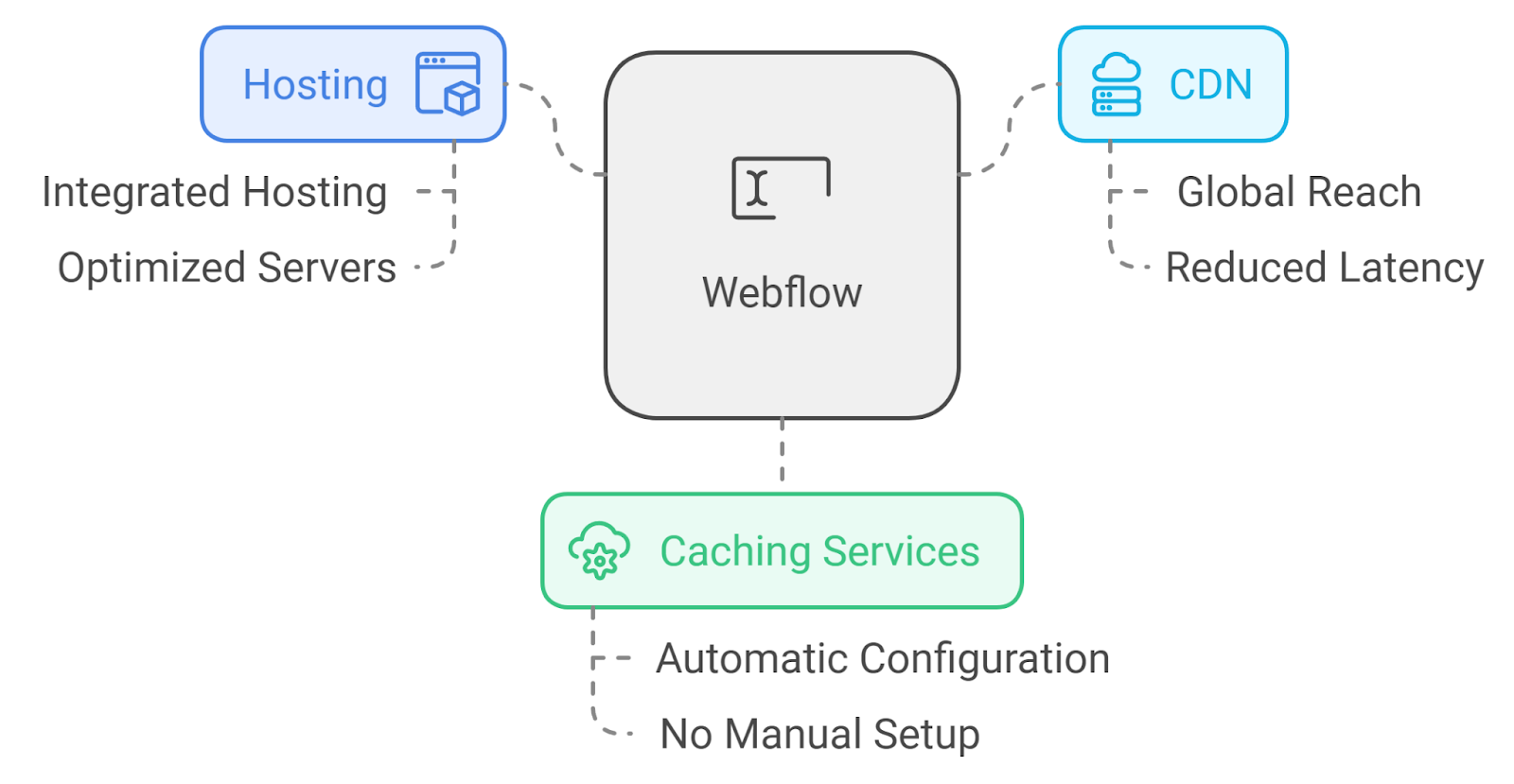
On the other hand, WordPress can be faster and more efficient, but it takes a bit more work. Your website's speed depends on the hosting service you pick and how you set it up. You'll also need to install caching plugins and use a CDN to keep your site running quickly.
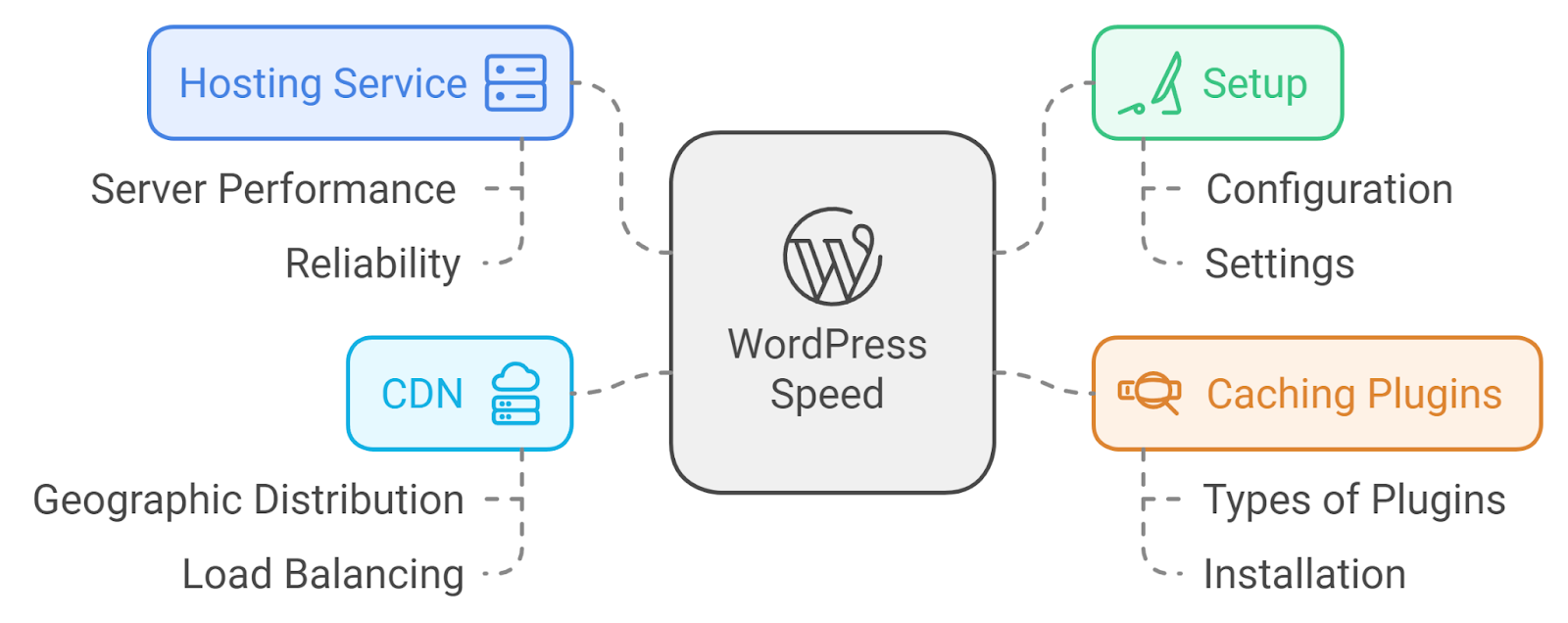
Webflow is great if you want a quick website that doesn't require much work. WordPress can be very fast, even faster than Webflow, but you'll have to manage it yourself.
SEO comparison
Webflow offers built-in SEO features that are easy to use. You can customize meta titles, descriptions, alt text, and URLs without using any plugins. Webflow offers clean and well-structured code that is great for search engines. It automatically generates sitemaps and supports mobile-first indexing. These built-in tools make it easy for you to manage SEO effectively.
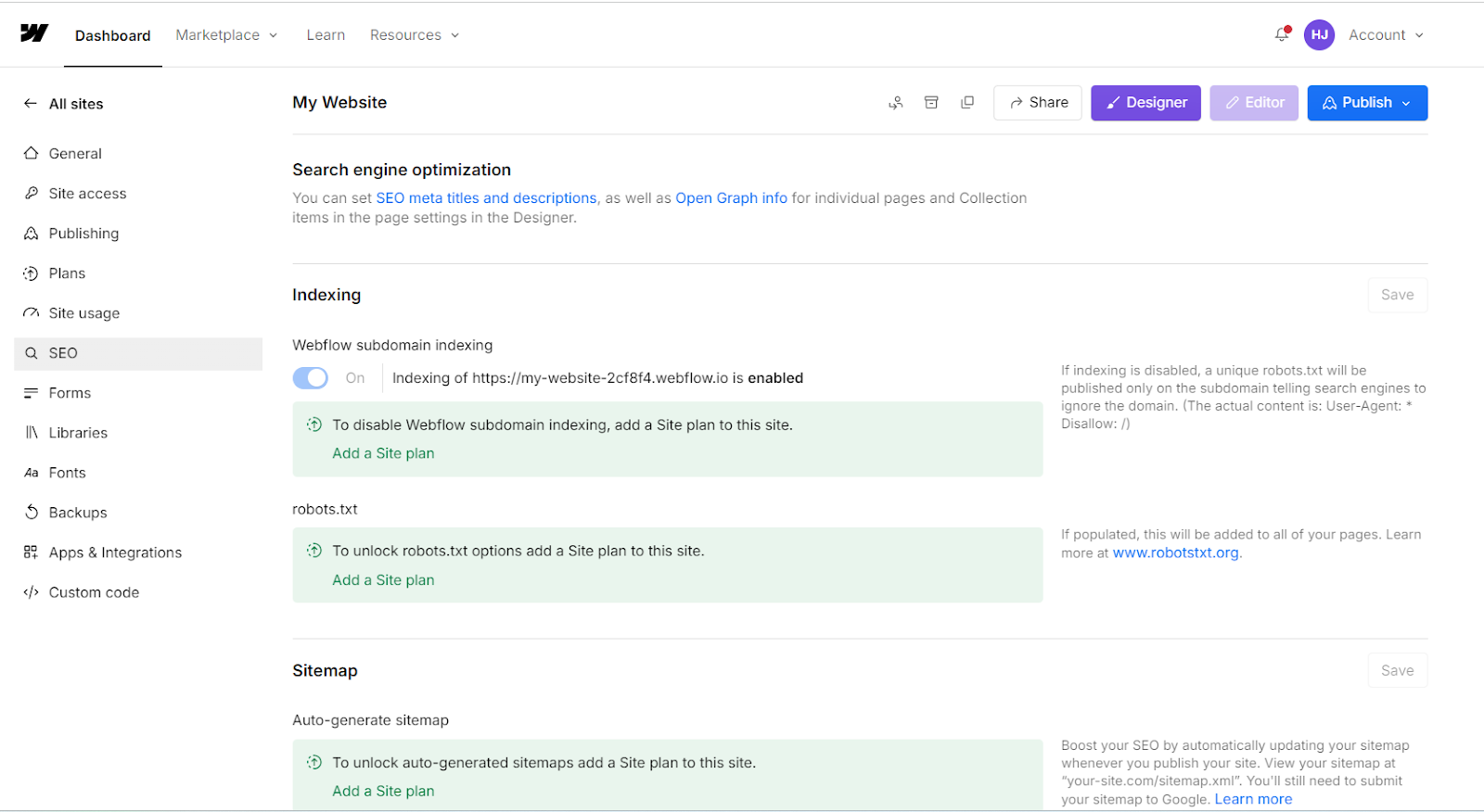
On the flip side, WordPress is super flexible but usually needs extra plugins for advanced SEO. Select from more than 5,000 SEO plugins, like Yoast SEO or Rankmath, to help you manage metadata and sitemaps and check your content performance.
Using too many plugins can slow down your site, though, which isn't great for SEO. However, if you optimize everything properly, WordPress can rank extremely well in searches. WordPress also allows you to customize your site's URLs and structure.
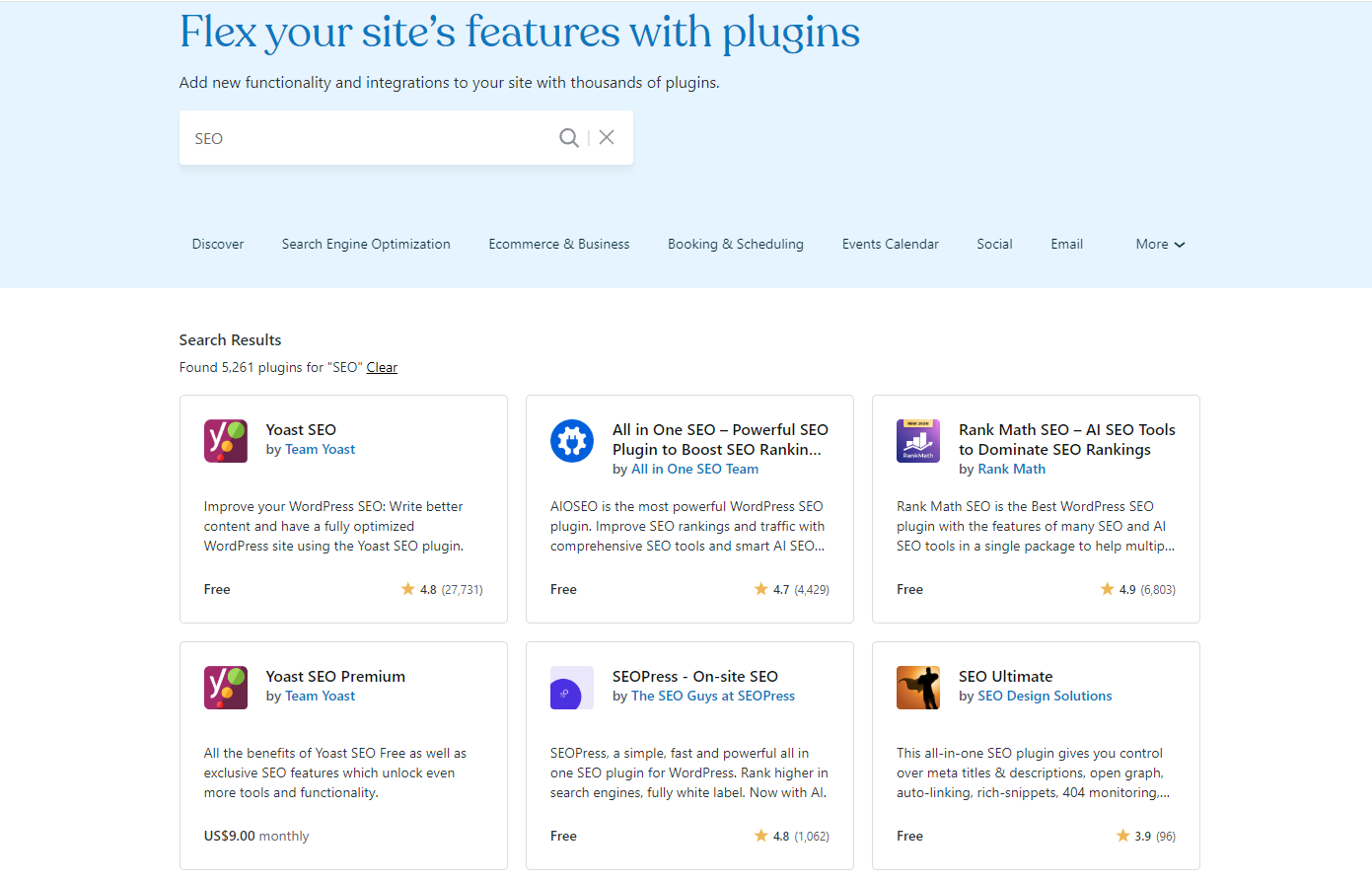
In a nutshell, if you want something easy to use with solid SEO right out of the box, Webflow is a great choice. If you prefer more flexibility and don't mind putting in a bit more work to optimize your site, WordPress could be the way to go.
Ecommerce compatibility
Webflow makes setting up an online store super easy with its built-in ecommerce tools. Once you choose the Ecommerce store option, you can either start from scratch or pick a template from the library. Webflow lets you create customizable product pages and offers a smooth checkout process.
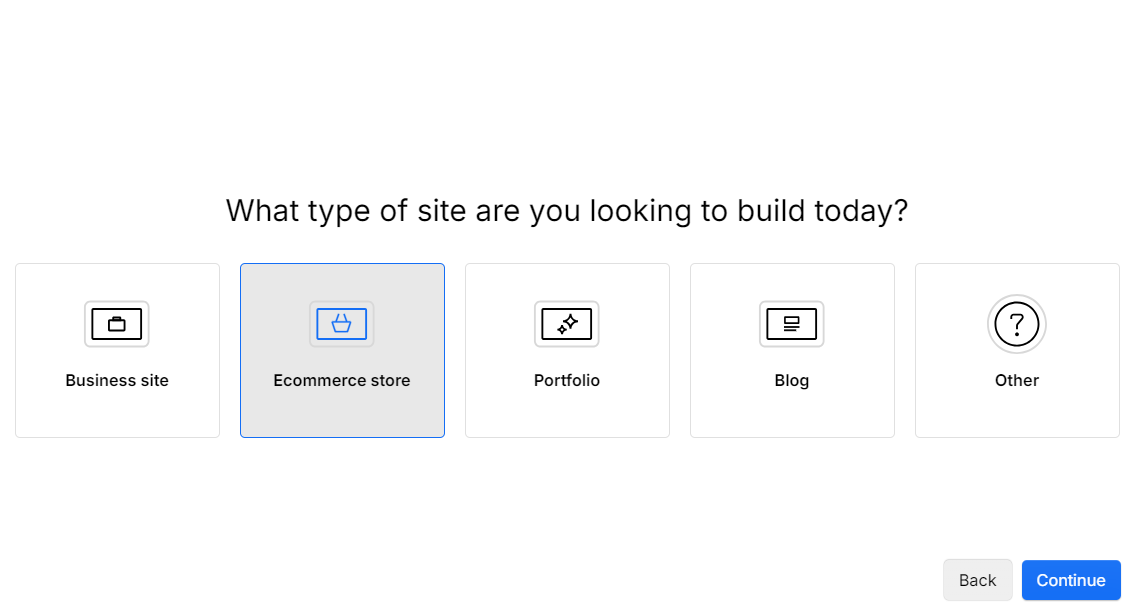
You can manage your inventory and orders easily, and you have full control over the look of your store using the Webflow design tools. It's great for smaller stores, but you might find Webflow a bit limited in options for bigger, more complex shops.

On the other hand, WordPress offers a dedicated ecommerce platform as a plugin called WooCommerce. It offers more advanced ecommerce features than the built-in Webflow features. It can turn any WordPress site into a fully functional store, with options like multiple payment gateways, advanced shipping, and detailed inventory management.
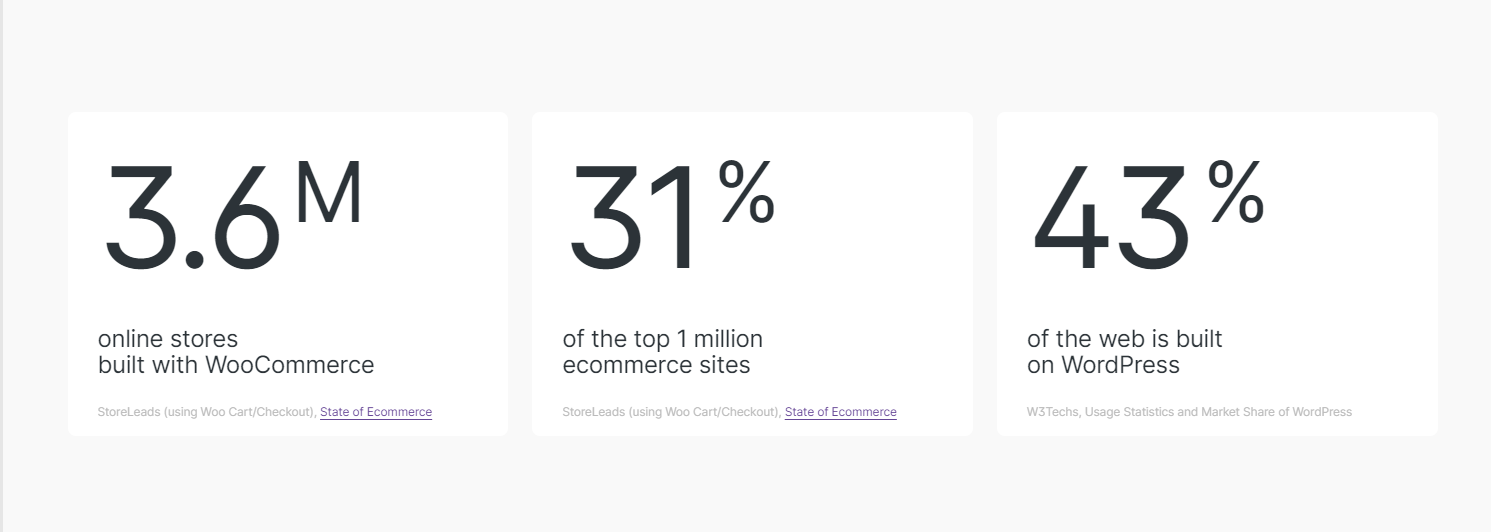
You can also customize everything—from product pages to the shopping cart—using WooCommerce add-ons, aligning the whole shop with your brand. It's super flexible and perfect for growing businesses that need more features.
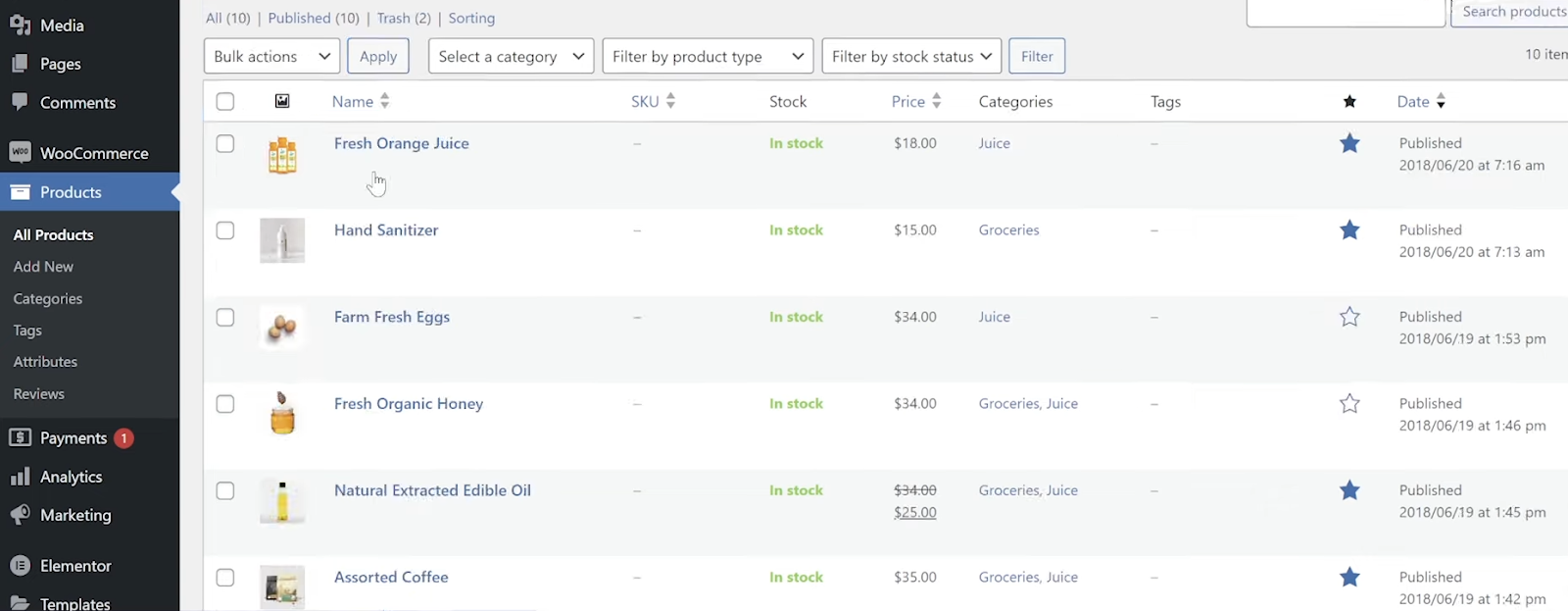
Community and ecosystem
Webflow is a growing platform with about 4 million users. The community might be smaller, but it's friendly and helpful. More people are joining every day, as Webflow is simple and fun to use. Notably, Webflow lacks extensive third-party services and community resources like WordPress. However, it's expanding with recent additions like Webflow Apps.
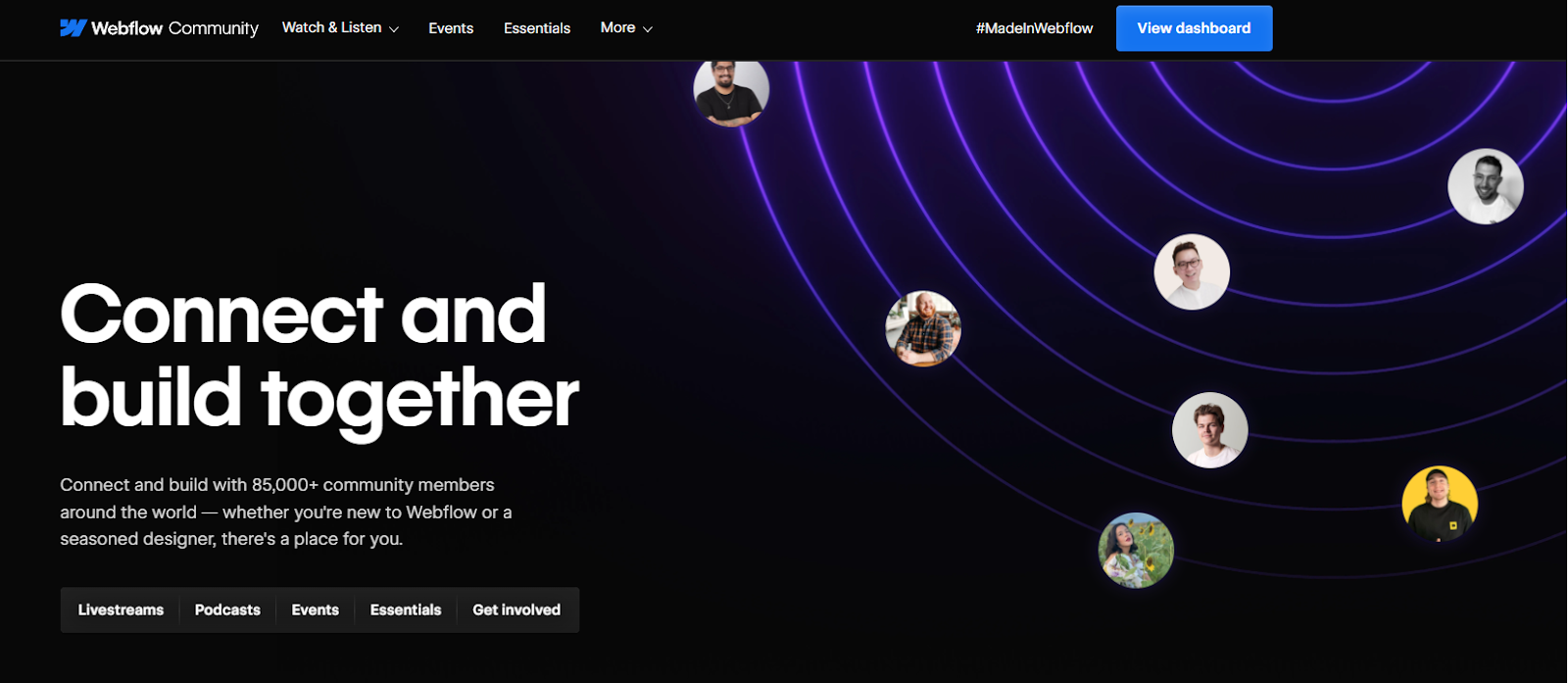
Webflow doesn't have huge third-party tools or apps, so you might have to use outside services for special features. With built-in tools, you can connect your site to services like Zapier, Airtable, and Google Analytics. Moreover, Webflow University and user forums offer useful tips, tutorials, and templates from other designers and developers.
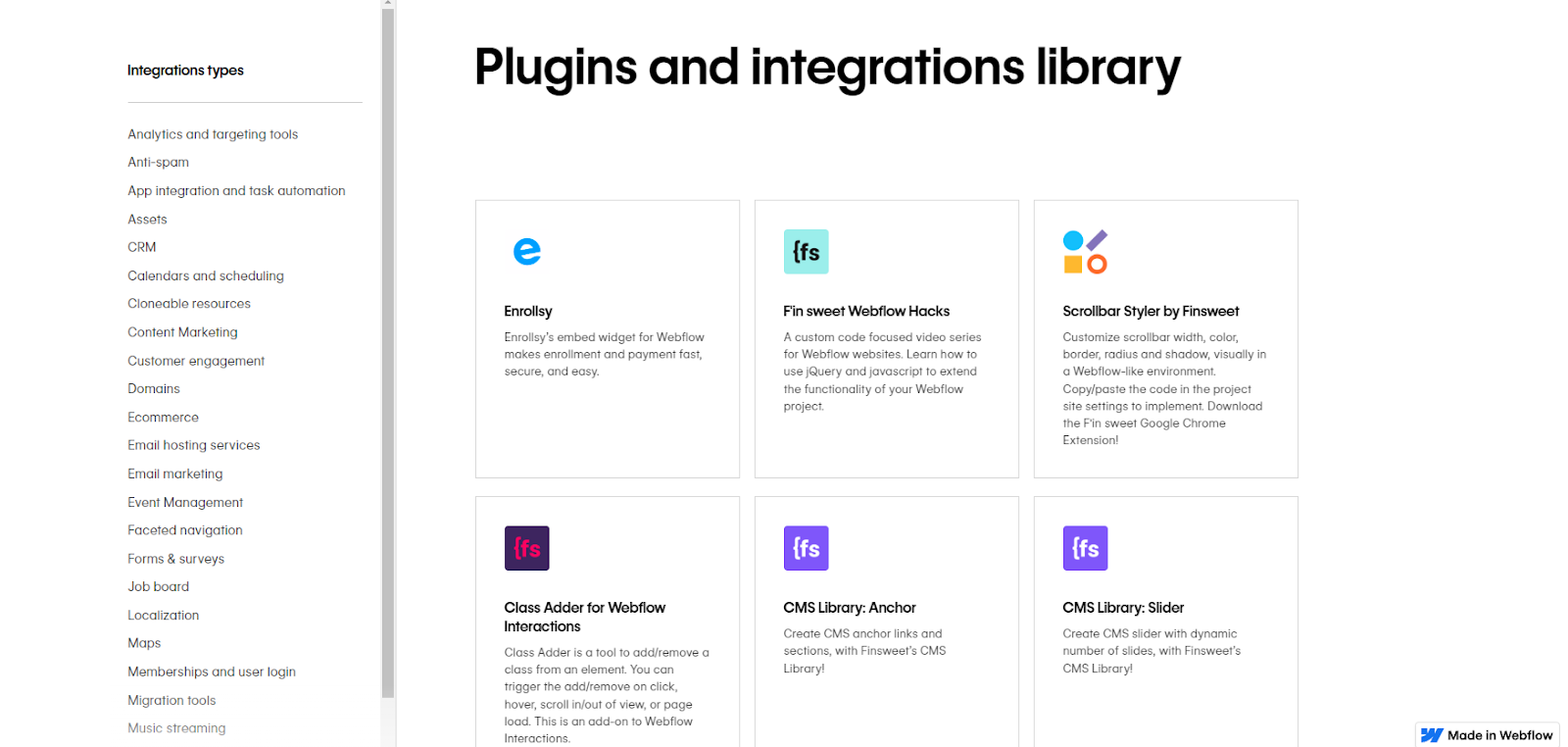
On the flip side, WordPress has an extensive and mature ecosystem. Thus, it's the most popular CMS globally, powering over 43% of all websites. The WordPress community is incredibly active, with regular WordCamps, meetups, and forums.
Countless resources like blogs, tutorials, and third-party services are also available. It allows all WordPress users, including bloggers, developers, and large enterprises, to find help and collaborate on projects.
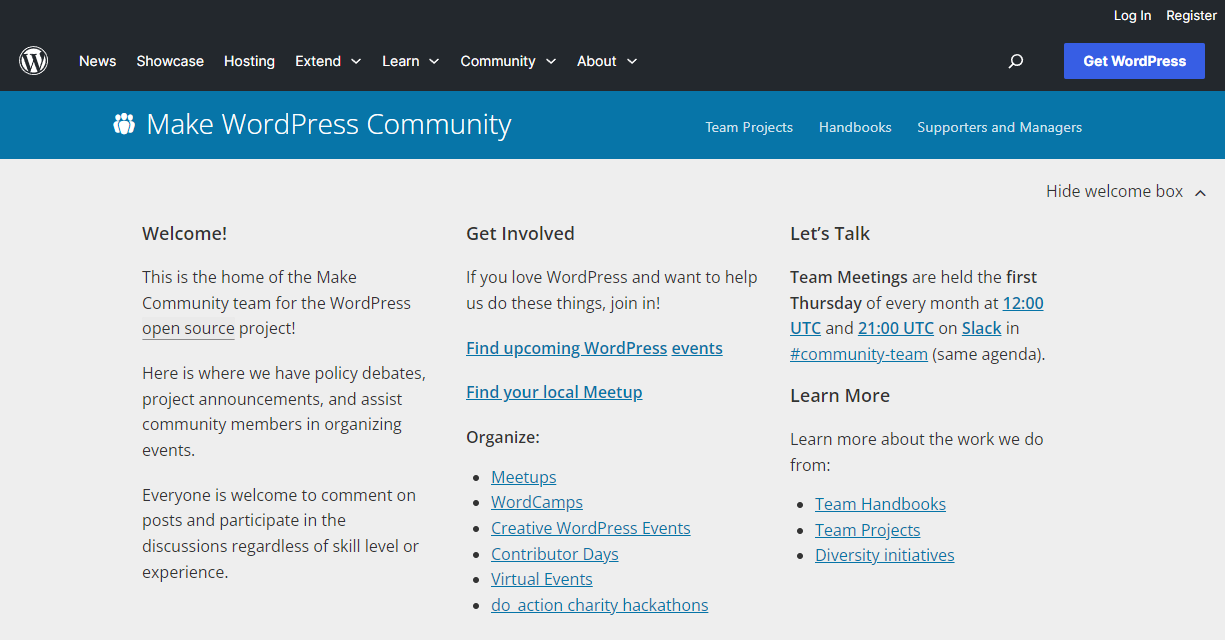
WordPress also has one of the largest ecosystems. It's an open-source platform, meaning anyone can build plugins, themes, and tools for it. You can access over 60,000 free premium options.
This massive plugin library allows you to extend your website's functionality in almost any way you can imagine—from SEO tools to ecommerce solutions. If you need any specific feature, chances are there's a plugin for it.
Multi-language support
Webflow makes it easy to create a multi-language website with its built-in localization features. You can add languages like English, Spanish, or French without needing any plugins.
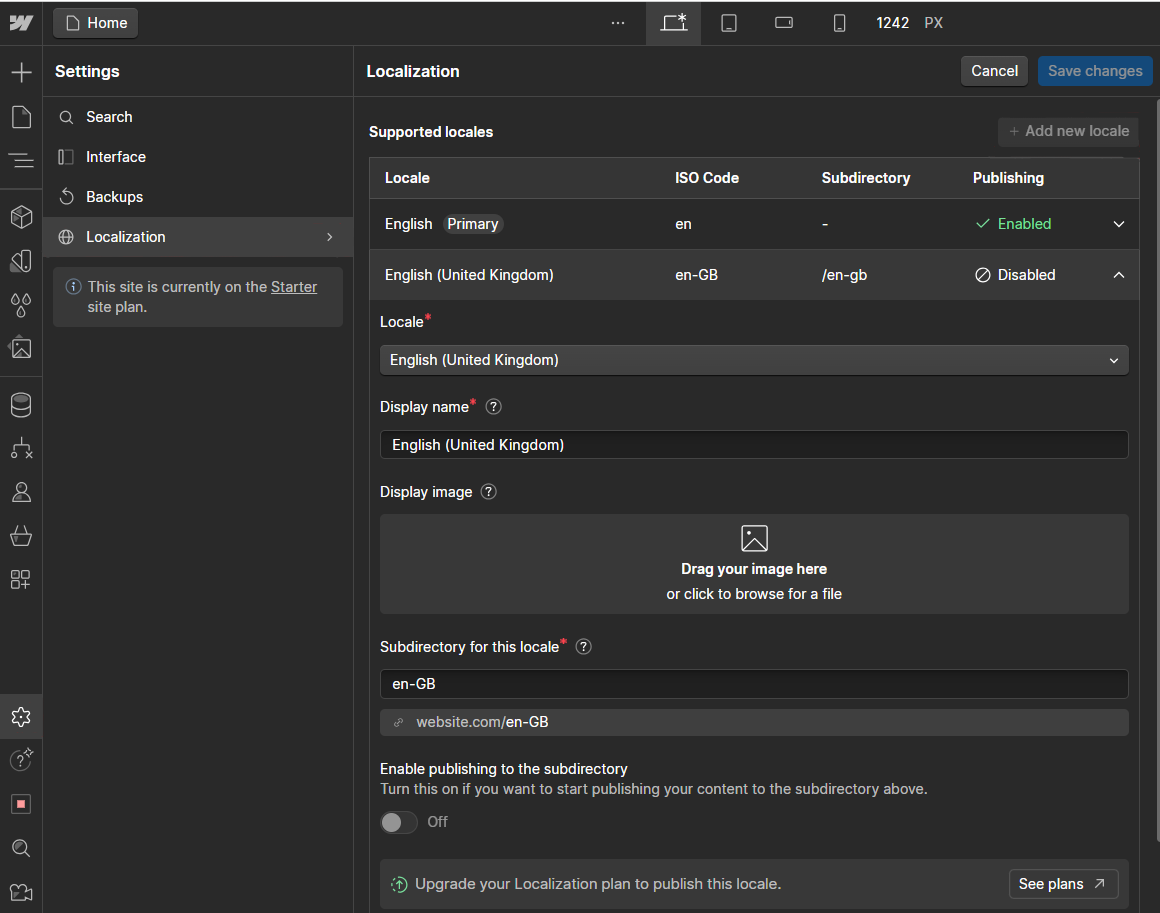
Webflow even lets you preview how your translations will look before publishing. However, if your site needs more advanced translation features, like handling lots of dynamic content in different languages, Webflow might feel a bit limited.
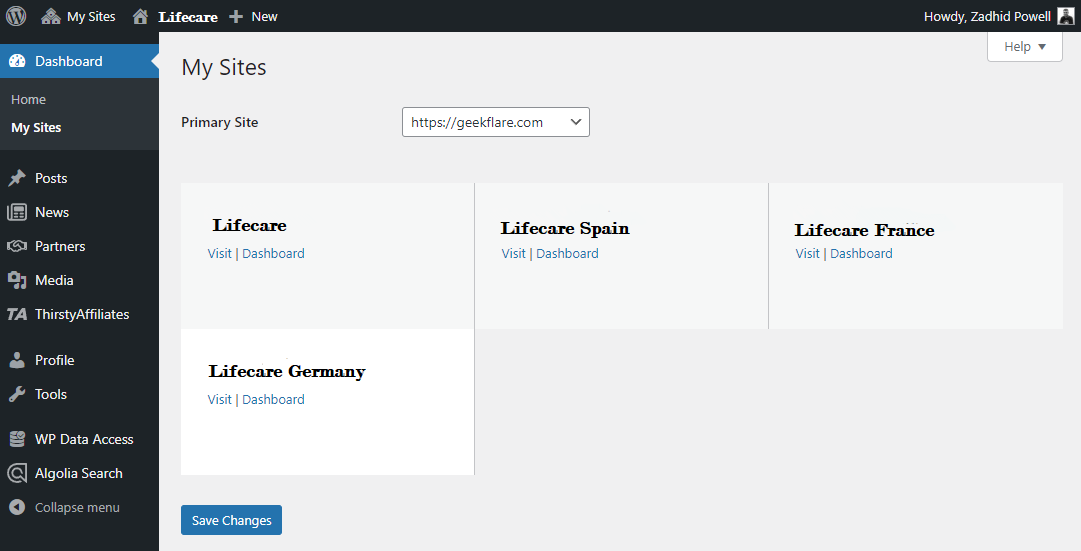
WordPress doesn’t have built-in multi-language support, but it works with powerful plugins like WPML or Polylang. These plugins let you translate anything on your site—pages, posts, menus, and more. WordPress can handle more complex multi-language setups and gives you better control, especially if your site needs advanced features like automatic translations or language-specific SEO.
If you want an easy, built-in solution for adding multiple languages, Webflow is a great choice. But if you need more control and advanced options for bigger multilingual sites, WordPress with plugins like WPML is the way to go.
The Verdict: Is Webflow or WordPress the Right Choice for Your Business?
Choosing between Webflow and WordPress comes down to what your project really needs, your comfort level with tech, and your budget. Let’s break it down to help you decide which one works best for you.
When to choose Webflow
- Design-focused projects: If design is your top priority and you want a stunning website, Webflow is the way. It’s super user-friendly and makes it easy to create custom designs.
- Small to medium-sized online stores: You can easily set up your shop, manage products, and have a stylish site without diving into anything too technical.
- Freelancers and creatives: Webflow shines in creativity. If you’re building a portfolio or a creative website to show off your work, Webflow makes it look polished and professional.
- Multi-lingual site: Webflow’s built-in translation tools make managing multi-language sites simple.
When to choose WordPress
- Content-heavy sites: If you’re building a blog or news site to handle tons of content, WordPress’s content management is hard to beat.
- Large ecommerce sites: With advanced needs like memberships or subscriptions, WordPress (with WooCommerce) is more flexible. You can add as many features as you want and scale up easily.
- Scalability: WordPress is great for growing businesses, with tons of plugins and themes to expand your site.
- Budget-friendly projects: If you’re on a tight budget, WordPress is very cost-effective. WordPress is free to start, and there are many affordable hosting options.
Supercharge Your Online Business With Whop
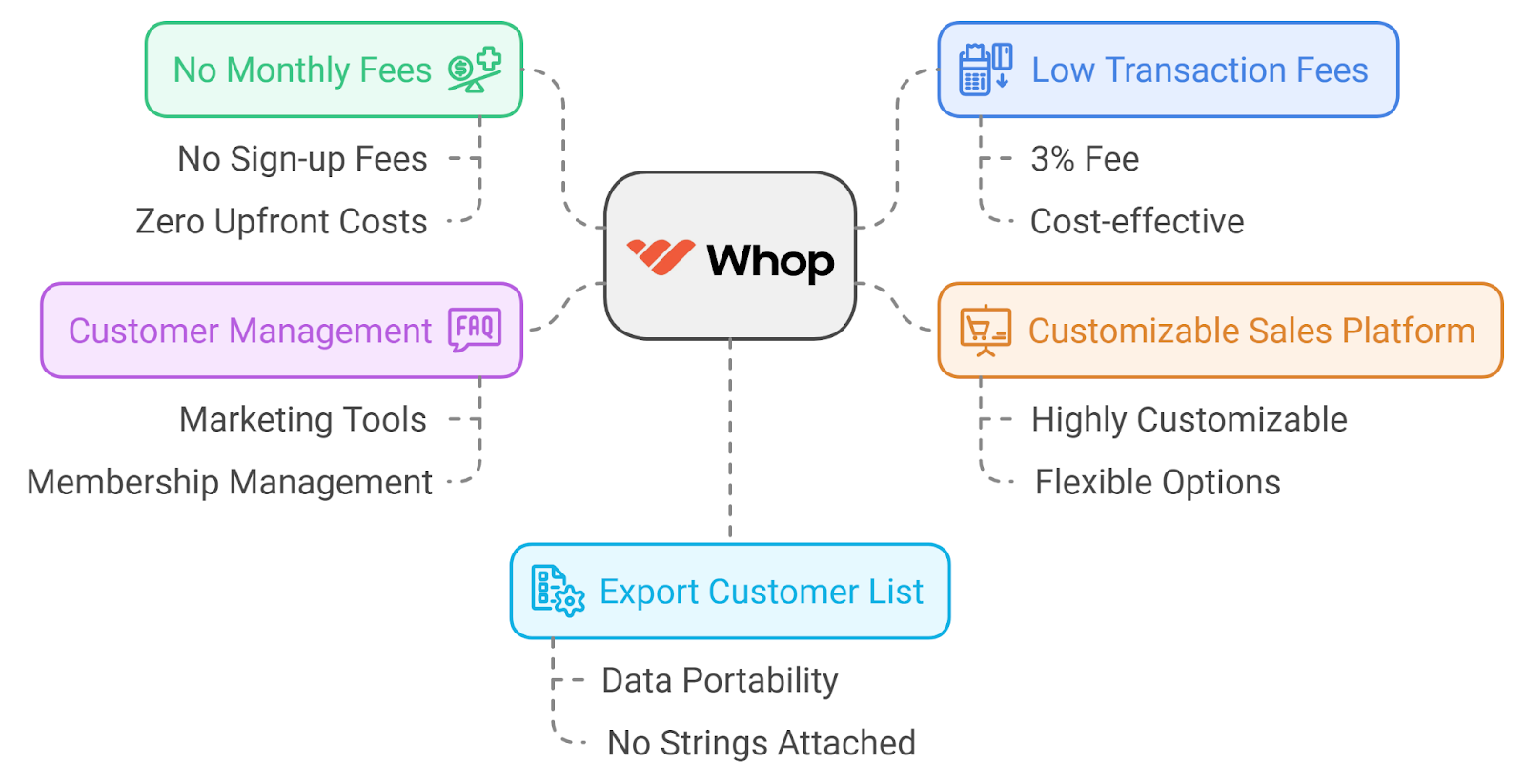
If you're thinking about selling digital products like ebooks or courses or even starting a subscription service, Whop makes it super easy for you. Unlike Webflow and WordPress, Whop is an all-in-one platform where you can sell your products and memberships. It handles all your marketing and customer management—all from one place.
The best part? Whop doesn't charge you any sign-up or monthly fees. You only pay a small 3% fee when you make a sale. So this makes it a low-risk way to grow your business without worrying about extra costs. You can start earning money right away without spending anything upfront.
Here's why Whop is awesome for selling your stuff:
- Sell any digital content
- No monthly fees
- Low fees (3%)
- Highly customizable sales platform
- You can export your customer list anytime—no strings attached!
If you're ready to kick off your online business with almost no hassle and no risk, Whop is the perfect place to start. Sign up today and start making money with your digital products.
FAQs
What's the main difference between Webflow and WordPress?
Webflow is great if you want to build a website using a simple drag-and-drop editor without learning to code. WordPress offers more control and customization, but you might need to know a bit about coding or use plugins to make it work just right.
Is Webflow or WordPress better for designers and developers?
Webflow is best for designers who like visual editing and animations. WordPress is better for developers who want more customization options and flexibility.
Is Webflow or WordPress easier for beginners?
Webflow is easier for beginners, with its intuitive drag-and-drop interface. In comparison, WordPress requires more time to learn because of its wide range of customization options.
Can you use Webflow or WordPress for free?
Yes, both WordPress and Webflow can be used for free. WordPress is free but may require paid hosting. Webflow has a free plan with limited features.
